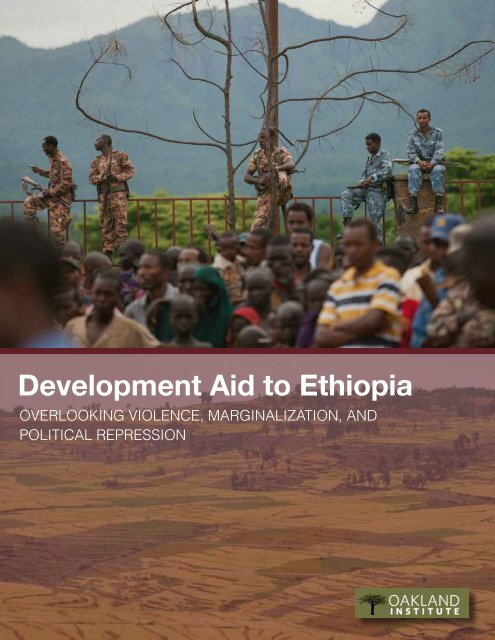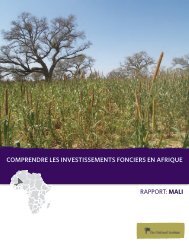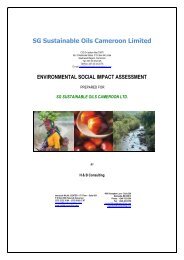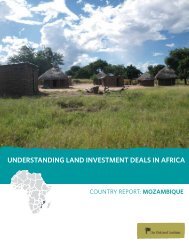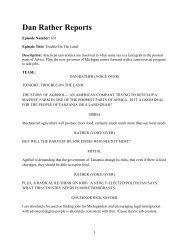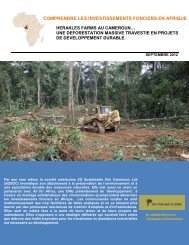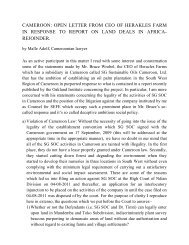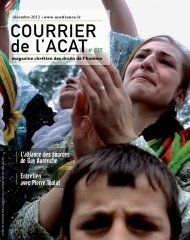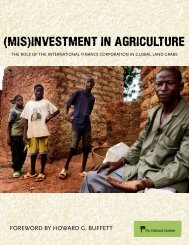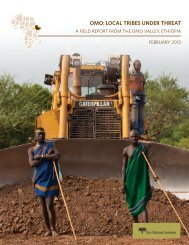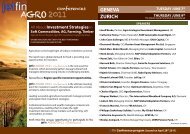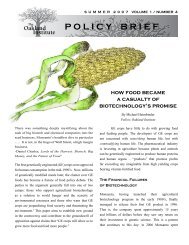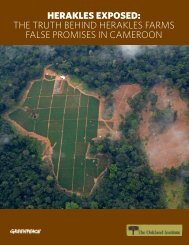Another report, also published by the Oakland Institute on Wednesday
Another report, also published by the Oakland Institute on Wednesday
Another report, also published by the Oakland Institute on Wednesday
- No tags were found...
You also want an ePaper? Increase the reach of your titles
YUMPU automatically turns print PDFs into web optimized ePapers that Google loves.
DEVELOPMENT AID TO ETHIOPIAOVERLOOKING VIOLENCE, MARGINALIZATION, ANDPOLITICAL REPRESSIONA Publicati<strong>on</strong> of <str<strong>on</strong>g>the</str<strong>on</strong>g> <str<strong>on</strong>g>Oakland</str<strong>on</strong>g> <str<strong>on</strong>g>Institute</str<strong>on</strong>g>
AcknowledgementsThis <str<strong>on</strong>g>report</str<strong>on</strong>g> was written <str<strong>on</strong>g>by</str<strong>on</strong>g> Luis Flores, a fellow with <str<strong>on</strong>g>the</str<strong>on</strong>g> <str<strong>on</strong>g>Oakland</str<strong>on</strong>g> <str<strong>on</strong>g>Institute</str<strong>on</strong>g>, in collaborati<strong>on</strong> with <str<strong>on</strong>g>the</str<strong>on</strong>g> <str<strong>on</strong>g>Oakland</str<strong>on</strong>g><str<strong>on</strong>g>Institute</str<strong>on</strong>g>’s research team headed <str<strong>on</strong>g>by</str<strong>on</strong>g> Frederic Mousseau. We are grateful to Lori Pottinger of Internati<strong>on</strong>alRivers and Felix Horne of Human Rights Watch for <str<strong>on</strong>g>the</str<strong>on</strong>g>ir thoughtful feedback <strong>on</strong> <str<strong>on</strong>g>the</str<strong>on</strong>g> <str<strong>on</strong>g>report</str<strong>on</strong>g>.The views and c<strong>on</strong>clusi<strong>on</strong>s expressed in this publicati<strong>on</strong> are those of <str<strong>on</strong>g>the</str<strong>on</strong>g> <str<strong>on</strong>g>Oakland</str<strong>on</strong>g> <str<strong>on</strong>g>Institute</str<strong>on</strong>g> al<strong>on</strong>e and do notreflect opini<strong>on</strong>s of <str<strong>on</strong>g>the</str<strong>on</strong>g> individuals and organizati<strong>on</strong>s that have sp<strong>on</strong>sored and supported <str<strong>on</strong>g>the</str<strong>on</strong>g> work.Editors: Frederic Mousseau and Melissa MooreFor photo credits, please email info@oaklandinstitute.orgCover photos: (top) Ethiopian army soldiers m<strong>on</strong>itoring Suri people during a festival in Kibish (bottom)Typical highland scene in Amhara (back) <str<strong>on</strong>g>the</str<strong>on</strong>g> Omo River in Korcho.Publisher: The <str<strong>on</strong>g>Oakland</str<strong>on</strong>g> <str<strong>on</strong>g>Institute</str<strong>on</strong>g> is a policy think tank dedicated to advancing public participati<strong>on</strong> and fairdebate <strong>on</strong> critical social, ec<strong>on</strong>omic, and envir<strong>on</strong>mental issues.Copyright © 2013 <str<strong>on</strong>g>by</str<strong>on</strong>g> The <str<strong>on</strong>g>Oakland</str<strong>on</strong>g> <str<strong>on</strong>g>Institute</str<strong>on</strong>g>The text may be used free of charge for <str<strong>on</strong>g>the</str<strong>on</strong>g> purposes of advocacy, campaigning, educati<strong>on</strong>, and research,provided that <str<strong>on</strong>g>the</str<strong>on</strong>g> source is acknowledged in full. The copyright holder requests that all such uses beregistered with <str<strong>on</strong>g>the</str<strong>on</strong>g>m for impact assessment purposes. For copying in any o<str<strong>on</strong>g>the</str<strong>on</strong>g>r circumstances, reuse in o<str<strong>on</strong>g>the</str<strong>on</strong>g>rpublicati<strong>on</strong>s, or translati<strong>on</strong> or adaptati<strong>on</strong>, permissi<strong>on</strong> must be secured.Please email info@oaklandinstitute.orgThe <str<strong>on</strong>g>Oakland</str<strong>on</strong>g> <str<strong>on</strong>g>Institute</str<strong>on</strong>g>PO Box 18978<str<strong>on</strong>g>Oakland</str<strong>on</strong>g>, CA 94619USAwww.oaklandinstitute.org
Table of C<strong>on</strong>tentsLIST OF ABBREVIATIONSEXECUTIVE SUMMARY 1INTRODUCTION 3INTERNATIONAL DEVELOPMENT AID TO ETHIOPIA 5Historical C<strong>on</strong>text of Foreign Aid 5Famine and <str<strong>on</strong>g>the</str<strong>on</strong>g> Politics of Hunger 6Human Rights Violati<strong>on</strong>s 7Crackdown <strong>on</strong> Dissent 8DEVELOPMENT AID, VILLAGIZATION, AND“POLITICAL CAPTURE”: HIDING BEHIND DEVELOPMENT 10Background <strong>on</strong> Major D<strong>on</strong>ors 11USAID’s Agricultural Development Initiatives 14Promoting Basic Services (PBS) 16Ethiopia’s Nati<strong>on</strong>al Food Security Program 18Gibe III Dam 21THE DIFFERENT FORMS OF COMPLICITY 23D<strong>on</strong>or Investigati<strong>on</strong>s Overlooking Evidence 23C<strong>on</strong>tradicti<strong>on</strong>s between Development Aid Policy and Practice 24Funding <str<strong>on</strong>g>the</str<strong>on</strong>g> Development State 26CONCLUSION 27
List of Acr<strong>on</strong>ymsAIDSDAGDfIDEDFELAPELTAPEPRDFFTFGEQIPGTPHABPHIVIDANFSPODAPBSPSCBPPSNPREILACSLUSAIDWBGAcquired Immunodeficiency SyndromeDevelopment Assistance Group EthiopiaBritish Department for Internati<strong>on</strong>al DevelopmentEthiopian Defense ForceEthiopia Streng<str<strong>on</strong>g>the</str<strong>on</strong>g>ning Land Administrati<strong>on</strong> ProgramEthiopian Land Tenure Policy and Administrati<strong>on</strong> ProgramEthiopian People’s Revoluti<strong>on</strong>ary Democratic Fr<strong>on</strong>tFeed <str<strong>on</strong>g>the</str<strong>on</strong>g> FutureGeneral Educati<strong>on</strong> Quality Improvement PackageGrowth and Transformati<strong>on</strong> PlanHousehold Asset Building ProgramHuman Immunodeficiency VirusWorld Bank’s Internati<strong>on</strong>al Development Associati<strong>on</strong>Nati<strong>on</strong>al Food Security ProgramOverseas Development AssistanceEthiopian Protecti<strong>on</strong> of Basic Services Program (Phases I, II, III)Public Sector Capacity Building ProgramProductive Safety Net ProgramResp<strong>on</strong>sible and Innovative Land Administrati<strong>on</strong> in EthiopiaCivil Society LawUnited States Agency for Internati<strong>on</strong>al DevelopmentWorld Bank Group
éc<strong>on</strong>omieLa NR 4692 – Mardi 23 juillet 20137PortugalB<strong>on</strong>ne réacti<strong>on</strong> des marchésà la stabilisati<strong>on</strong> politique, Le taux d'empruntà 10 ans du Portugalenregistrait une nettedétente et la Bourse deLisb<strong>on</strong>ne gagnait près de2,5% hier matin, suite ausoutien apporté par leprésident portugais à lacoaliti<strong>on</strong>gouvernementale.Face à la perspective de voir sedissiper la crise politique qui perduraitdepuis trois semaines dansce pays sous assistance financièreinternati<strong>on</strong>ale, le taux portugais,qui évolue en sens inverse de lademande, se détendait à 6,537%vers 9H GMT, c<strong>on</strong>tre 6,799% vendredisoir à la clôture, sur le marchésec<strong>on</strong>daire où s'échange ladette déjà émise.«Au Portugal, après la déclarati<strong>on</strong>de ce week-end du président de laRépublique, le risque d’électi<strong>on</strong>anticipée est en net recul, le calmedevrait revenir sur les marchéspour la dette portugaise», <strong>on</strong>t estiméles analystes de Aurel BGC. Aumême moment, le PSI-20, l'indicevedette de la Bourse de Lisb<strong>on</strong>ne,progressait de 2,46% à 5.660,22points, avec 19 de ses 20 titres dansle vert.Les valeurs financières enregistraientles plus fortes hausses: labanque Banif s'envolait de 10,42%,la BES b<strong>on</strong>dissait de 7,42%, la BCPde 6,67% et la BPI de 6,04%. Parmiles poids-lourds de la place portugaise,Portugal Telecom gagnait2,9% et le groupe pétrolier et gazierGalp s'appréciait de 1,32%. En revanche,le groupe de distributi<strong>on</strong>Jer<strong>on</strong>imo Martins reculait de 0,35%.BourseDimanche soir, lors d'une déclarati<strong>on</strong>solennelle, le président c<strong>on</strong>servateur,Anibal Cavaco Silva, a déclaréc<strong>on</strong>sidérer que «la meilleuresoluti<strong>on</strong> est de maintenir en f<strong>on</strong>cti<strong>on</strong>sl'actuel gouvernement».«Dans l'actuel c<strong>on</strong>texte d'urgencenati<strong>on</strong>ale, la c<strong>on</strong>vocati<strong>on</strong> d'électi<strong>on</strong>sn'est pas une soluti<strong>on</strong> pourles problèmes que le Portugal affr<strong>on</strong>te»,a-t-il ajouté, rejetant ainsiles appels de l'ensemble de l'oppositi<strong>on</strong>de gauche en faveur d'unedissoluti<strong>on</strong> du Parlement.Depuis le début du mois de juillet,la coaliti<strong>on</strong> du Premier ministre,Pedro Passos Coelho, est ébranléepar la démissi<strong>on</strong> de deux ministresclés sur f<strong>on</strong>d de tensi<strong>on</strong>sTokyo finit en hausse de 0,47%,La Bourse de Tokyo a fini hier enhausse de 0,47%, alors que le yenest rem<strong>on</strong>té, repassant juste sousla barre des 100 pour un dollar,au lendemain de la victoire électoralede Shinzo Abe.L'indice Nikkei a gagné 68,13 pointsà 14.658,04 points et le Topix, pluslarge, a pris 4,55 points (+0,38%) à1.216,53 points.La coaliti<strong>on</strong> du Premier ministre jap<strong>on</strong>aisa remporté dimanche unevictoire décisive aux électi<strong>on</strong>s sénatoriales,ce qui renforce sa Après la déclarati<strong>on</strong> du président de la République, le risque d’électi<strong>on</strong> anticipée est en net recul. (Photo > D. R.)marge de manœuvre pour relancer.«La victoire d'Abe était largementanticipée», commente TakuyaTakahashi, chez Daiwa Securities.Il souligne que cela a toutefoisd<strong>on</strong>né une t<strong>on</strong>alité positive aumarché en matinée parce que leslois ser<strong>on</strong>t plus facilement votéesau Parlement et que le score de dimanchec<strong>on</strong>tribuera à d<strong>on</strong>ner uneassise stable au gouvernement.Les valeurs exportatrices <strong>on</strong>t sousperforméavec le reb<strong>on</strong>d du yen.c<strong>on</strong>cernant la politique de rigueurque le Portugal s'est engagé àmettre en œuvre en échange d'unplan d'aide financière accordé enmai 2011 par l'Uni<strong>on</strong> européenne etle F<strong>on</strong>ds m<strong>on</strong>étaire internati<strong>on</strong>al.Le taux d'emprunt du Portugal étaitalors passé au-dessus de 8% pourla première fois depuis novembre2012. Face aux appels à la resp<strong>on</strong>sabilitévenus d'Europe et à l'affolementdes marchés financiers, leParti social démocrate (PSD, centreArmementdroit) du Premier ministre et s<strong>on</strong>partenaire de coaliti<strong>on</strong> démocratechrétien, le CDS-PP de Paulo Portas,se s<strong>on</strong>t mis d'accord pour sauverleur majorité. Ils <strong>on</strong>t ainsi décidéque M. Portas, qui avait quittés<strong>on</strong> poste de ministre des Affairesétrangères, resterait au gouvernement,promu au rang de vice-Premierministre chargé de la politiqueéc<strong>on</strong>omique et des relati<strong>on</strong>savec les créanciers du pays.R. E./AgencePremier gros c<strong>on</strong>trat militaire envue pour la France à Abou Dhabi,Le ministre français de laDéfense Jean-Yves Le Driandevait signer hier unc<strong>on</strong>trat avec les EmiratsArabes Unis pour la ventede deux satellitesmilitaires d<strong>on</strong>t le m<strong>on</strong>tantest estimé à 800 milli<strong>on</strong>sd'euros.Le ministre français de la DéfenseJean-Yves Le Drian s’estrendu hier à Abou Dhabi. La visitea pour objectif la signatured'un gros c<strong>on</strong>trat d'exportati<strong>on</strong>militaire d<strong>on</strong>t l'objet est lavente de deux satellites militairesd'observati<strong>on</strong> fabriquésen coopérati<strong>on</strong> par Astrium etThales Alenia Space. Le m<strong>on</strong>tantdu c<strong>on</strong>trat est estimé à 800milli<strong>on</strong>s d'euros.Ce premier grand c<strong>on</strong>trat d'exportati<strong>on</strong>militaire du gouvernementsocialiste a été remportéde haute lutte par les deuxagences spaciales françaisesdevant l'américain LockheedMartin. Ce succès, souligne-t<strong>on</strong>dans l'entourage du ministre,doit beaucoup à Jean-Yves Le Drian qui s'est investipour rétablir une relati<strong>on</strong> dégradéeavec les Emirats. Clienttraditi<strong>on</strong>nel de l'industrie militairefrancaise, ce pays n'avaitplus passé de commande significativedepuis que la France aouvert en 2008 à Abou Dhabi saseule base militaire en dehorsd'Afrique.Le ministre s'est attaché ànouer des relati<strong>on</strong>s dec<strong>on</strong>fiance avec le prince héritierdes EAU, cheikh Mohammedben Zayed al Nahyan, defaç<strong>on</strong> à favoriser les négociati<strong>on</strong>sdes industriels, dit-<strong>on</strong>dans s<strong>on</strong> entourage. Astrium,divisi<strong>on</strong> espace du groupe europeenEADS, et TAS, coentreprisedu francais Thales et del'italien Finmeccanica, <strong>on</strong>t faillise faire souffler le marché parLockheed Martin, qui proposaitun satellite d<strong>on</strong>t le Pentag<strong>on</strong>eavait annulé la commandec<strong>on</strong>tre leurs deux satellites Helios.Même une visite de troisjours, plus tôt en juillet, à AbouDhabi, où le ministre avait accompagnéles négociateurs,n'avait pas permis de c<strong>on</strong>clure.VoirsurInternetwww.lnr-dz.comI N F O SE X P R E S SAutomobilePeugeot envisageraitde céder une partiede Banque PSALe c<strong>on</strong>structeur automobile PSAPeugeot Citroën envisage de céderà l'espagnol Santander une partiede sa filiale bancaire Banque PSAFinance, rapporte le Wall StreetJournal. PSA a engagé des«discussi<strong>on</strong>s préliminaires» avecSantander, qui pourrait prendrejusqu'à la moitié du capital oufusi<strong>on</strong>ner les activités de BanquePSA Finance avec les siennes,affirme le journal américain, quicite «des sources proches desdiscussi<strong>on</strong>s». Une telle opérati<strong>on</strong>permettrait à PSA de ne plusdépendre de la garantie de créditde 7 milliards d'euros accordée l'andernier par le gouvernementfrançais. Ce dispositif est dans leradar des autorités européennesde la c<strong>on</strong>currence, qui enquêtentpour savoir s'il peut être c<strong>on</strong>sidérécomme une aide publique n<strong>on</strong>justifiée. Sel<strong>on</strong> le quotidien, PSAserait également en discussi<strong>on</strong>savec d'autres banques, «afin derenforcer l'accès au refinancementde Banque PSA dans certainspays».ChineGSK admet depossibles infracti<strong>on</strong>s,Astra viséLe laboratoire britanniqueGlaxoSmithKline, visé par une enquêtepour corrupti<strong>on</strong> en Chine, a admis hierque certains de ses dirigeantssemblent avoir enfreint la loi du pays,tandis que s<strong>on</strong> c<strong>on</strong>current AstraZenecaa ann<strong>on</strong>cé avoir reçu la visite de lapolice à Shanghai. «Certains de nosdirigeants de GSK Chine, quic<strong>on</strong>naissent bien notre faç<strong>on</strong> def<strong>on</strong>cti<strong>on</strong>ner, semblent avoir agi endehors de nos processus et c<strong>on</strong>trôles,d'une faç<strong>on</strong> qui enfreint la loichinoise», a déclaré Abbas Hussain,directeur internati<strong>on</strong>al de GSK pourl'Europe, le Jap<strong>on</strong>, les pays émergentset l'Asie. «Nous av<strong>on</strong>s une tolérancezéro pour ce genre decomportements», a-t-il ajouté, àl'issue d'une renc<strong>on</strong>tre avec desreprésentants du ministère chinois dela Sécurité publique. Les autoritéschinoises avaient ann<strong>on</strong>cé débutjuillet avoir ouvert une enquête c<strong>on</strong>treGSK, accusé d'avoir versé des pots-devinsces dernières années à desf<strong>on</strong>cti<strong>on</strong>naires, des firmes du secteurpharmaceutique, ainsi qu'à deshôpitaux et des médecins pour doperles ventes de ses produits en Chine.Près de 500 milli<strong>on</strong>s de dollarsauraient été versés en pots-de-vins,par l'intermédiaire d'agences devoyages et de projets de sp<strong>on</strong>soring,sel<strong>on</strong> la police.
Internati<strong>on</strong>al d<strong>on</strong>ors, seemingly c<strong>on</strong>cerned withnot being formally associated with <str<strong>on</strong>g>the</str<strong>on</strong>g> governmentof Ethiopia’s Resettlement Program, claim that nodirect funding goes to <str<strong>on</strong>g>the</str<strong>on</strong>g> program, but <str<strong>on</strong>g>the</str<strong>on</strong>g>se samed<strong>on</strong>ors provide substantial resources to <str<strong>on</strong>g>the</str<strong>on</strong>g> o<str<strong>on</strong>g>the</str<strong>on</strong>g>rpillars of <str<strong>on</strong>g>the</str<strong>on</strong>g> Nati<strong>on</strong>al Food Security Program.This approach allows <str<strong>on</strong>g>the</str<strong>on</strong>g>m to claim <str<strong>on</strong>g>the</str<strong>on</strong>g>y are notsupporting or participating in any wr<strong>on</strong>gdoing,however <str<strong>on</strong>g>the</str<strong>on</strong>g>ir overall funding for this sector al<strong>on</strong>gwith <str<strong>on</strong>g>the</str<strong>on</strong>g> Ethtiopian government’s own resources,allows <str<strong>on</strong>g>the</str<strong>on</strong>g> resettlement program to take place.Fur<str<strong>on</strong>g>the</str<strong>on</strong>g>rmore, <str<strong>on</strong>g>the</str<strong>on</strong>g> World Bank is providing indirectfunding (through <str<strong>on</strong>g>the</str<strong>on</strong>g> support of a transmissi<strong>on</strong> line)to <str<strong>on</strong>g>the</str<strong>on</strong>g> c<strong>on</strong>troversial Gibe III Dam, which, <strong>on</strong>cecomplete, will provide not just electricity but <str<strong>on</strong>g>also</str<strong>on</strong>g>water for <str<strong>on</strong>g>the</str<strong>on</strong>g> irrigati<strong>on</strong> of large plantati<strong>on</strong>s <strong>on</strong> landthat is being usurped from <str<strong>on</strong>g>the</str<strong>on</strong>g> ethnic communitiesof South Omo.While it is critical to provide assistance to agriculturalinvestment and <str<strong>on</strong>g>the</str<strong>on</strong>g> improvement of livelihoods andfood security in Ethiopia, <str<strong>on</strong>g>the</str<strong>on</strong>g> current approach ofinternati<strong>on</strong>al d<strong>on</strong>ors is resulting in <str<strong>on</strong>g>the</str<strong>on</strong>g> opposite effect.The <str<strong>on</strong>g>Oakland</str<strong>on</strong>g> <str<strong>on</strong>g>Institute</str<strong>on</strong>g> calls for truly independentinvestigati<strong>on</strong>s, c<strong>on</strong>ducted <str<strong>on</strong>g>by</str<strong>on</strong>g> internati<strong>on</strong>al experts,into <str<strong>on</strong>g>the</str<strong>on</strong>g> impact of “development” programs currentlybeing implemented in Ethiopia and into <str<strong>on</strong>g>the</str<strong>on</strong>g> role ofd<strong>on</strong>or funds in <str<strong>on</strong>g>the</str<strong>on</strong>g> villagizati<strong>on</strong> program and o<str<strong>on</strong>g>the</str<strong>on</strong>g>rallegati<strong>on</strong>s of violence stemming from developmentinitiatives. Ethiopia’s key d<strong>on</strong>ors should support thisdemand in order to allow accurate and objectiveinformati<strong>on</strong> to surface and to ensure that <str<strong>on</strong>g>the</str<strong>on</strong>g>ir aidis not being used to restrict freedoms, violate humanrights, or stifle democracy.The US State Department 3 and independententities that have c<strong>on</strong>ducted investigati<strong>on</strong>s haveacknowledged <str<strong>on</strong>g>the</str<strong>on</strong>g> increasingly repressive policies of<str<strong>on</strong>g>the</str<strong>on</strong>g> Ethiopian People’s Revoluti<strong>on</strong>ary DemocraticFr<strong>on</strong>t, <str<strong>on</strong>g>the</str<strong>on</strong>g> nati<strong>on</strong>’s ruling party. Proclamati<strong>on</strong>srestricting <str<strong>on</strong>g>the</str<strong>on</strong>g> operating of civil society organizati<strong>on</strong>sand <str<strong>on</strong>g>the</str<strong>on</strong>g> exercise of free press are legitimized under <str<strong>on</strong>g>the</str<strong>on</strong>g>banner of fighting terrorism. Accounts of unjustlyincarcerated journalists are reflective of what hasbeen called <str<strong>on</strong>g>the</str<strong>on</strong>g> state’s “architecture of repressi<strong>on</strong>.”The US has suggested that it has decided to turn ablind eye to <str<strong>on</strong>g>the</str<strong>on</strong>g> “democracy deficit” of <str<strong>on</strong>g>the</str<strong>on</strong>g> regimebecause <str<strong>on</strong>g>the</str<strong>on</strong>g> “positive role played <str<strong>on</strong>g>by</str<strong>on</strong>g> Ethiopia within<str<strong>on</strong>g>the</str<strong>on</strong>g> Horn of Africa regi<strong>on</strong> is a str<strong>on</strong>g basis for USGc<strong>on</strong>structive engagement with Ethiopia.” 42 | The <str<strong>on</strong>g>Oakland</str<strong>on</strong>g> <str<strong>on</strong>g>Institute</str<strong>on</strong>g>
Excavator at work, Mago.Introducti<strong>on</strong>Ethiopia, <strong>on</strong>ce described <str<strong>on</strong>g>by</str<strong>on</strong>g> former President BillClint<strong>on</strong> as a nati<strong>on</strong> in “renaissance,” remains aland of c<strong>on</strong>tradicti<strong>on</strong>s. 5 The sec<strong>on</strong>d most populousnati<strong>on</strong> in <str<strong>on</strong>g>the</str<strong>on</strong>g> African c<strong>on</strong>tinent, Ethiopia remainsam<strong>on</strong>g <str<strong>on</strong>g>the</str<strong>on</strong>g> poorest, with a per capita average annualincome of $170. 6 Although it is c<strong>on</strong>sidered <strong>on</strong>e oftwo major “water towers” in Africa, chr<strong>on</strong>ic droughtshave become part of Ethiopia’s reality, c<strong>on</strong>tributingto severe food insecurity and widespread hunger.Am<strong>on</strong>g nati<strong>on</strong>s categorized as “developing,” Ethiopiamaintains a relatively low urban populati<strong>on</strong> at 17percent; most Ethiopians c<strong>on</strong>tinue to reside in ruralareas and 82 percent of <str<strong>on</strong>g>the</str<strong>on</strong>g> country’s populati<strong>on</strong>depends <strong>on</strong> subsistence agriculture. 7 These figuresare often presented in juxtapositi<strong>on</strong> to Ethiopia’shighly praised statistics <strong>on</strong> ec<strong>on</strong>omic growth. In<str<strong>on</strong>g>the</str<strong>on</strong>g> last decade, <str<strong>on</strong>g>the</str<strong>on</strong>g> Ethiopian ec<strong>on</strong>omy has grownbetween 4 and 7 percent every year. 8 Ethiopia is akey US strategic ally in <str<strong>on</strong>g>the</str<strong>on</strong>g> unstable Horn of Africaand <str<strong>on</strong>g>the</str<strong>on</strong>g> war against Islamist militants in Somalia.It hosts <str<strong>on</strong>g>the</str<strong>on</strong>g> Headquarters of <str<strong>on</strong>g>the</str<strong>on</strong>g> African Uni<strong>on</strong>,and <str<strong>on</strong>g>the</str<strong>on</strong>g> Ethiopian Prime Minister chairs <str<strong>on</strong>g>the</str<strong>on</strong>g> Uni<strong>on</strong>in 2013. Industrial interests have c<strong>on</strong>verged <strong>on</strong>Ethiopia as well, given its positi<strong>on</strong> <strong>on</strong> <str<strong>on</strong>g>the</str<strong>on</strong>g> “fast trackto progress.” 9 This combinati<strong>on</strong> of humanitarianneed and <str<strong>on</strong>g>the</str<strong>on</strong>g> Ethiopian government’s receptivenessto foreign investment and Western strategic interestshas made Ethiopia a “magnet for d<strong>on</strong>ors.” 10In recent years, Ethiopia has been receiving $3.5billi<strong>on</strong> <strong>on</strong> average from internati<strong>on</strong>al d<strong>on</strong>ors,which represents between 50 to 60 percent of itsnati<strong>on</strong>al budget. 11 The entities that have provided<str<strong>on</strong>g>the</str<strong>on</strong>g> most substantial development aid for <str<strong>on</strong>g>the</str<strong>on</strong>g> lastdecade are <str<strong>on</strong>g>the</str<strong>on</strong>g> US (through USAID and <str<strong>on</strong>g>the</str<strong>on</strong>g> StateDepartment), <str<strong>on</strong>g>the</str<strong>on</strong>g> World Bank Group, and <str<strong>on</strong>g>the</str<strong>on</strong>g>UK. 12 The government c<strong>on</strong>trolled <str<strong>on</strong>g>by</str<strong>on</strong>g> <str<strong>on</strong>g>the</str<strong>on</strong>g> EthiopianPeople’s Revoluti<strong>on</strong>ary Democratic Fr<strong>on</strong>t (EPRDF)has developed str<strong>on</strong>g development rhetoric inrecent years—going as far as describing Ethiopiaas a “development state.” 13 In 2006, it enacted<str<strong>on</strong>g>the</str<strong>on</strong>g> Accelerated and Sustained Development toDevelopment Aid To Ethiopia | 3
End Poverty (PASDEP) program, which began arestructuring of agricultural arrangements to increaseexports with <str<strong>on</strong>g>the</str<strong>on</strong>g> stated purpose of improving foodsecurity. 14 Proving effective at attracting large sumsof foreign assistance, <str<strong>on</strong>g>the</str<strong>on</strong>g> Ethiopian governmentrecently built <strong>on</strong> past efforts with <str<strong>on</strong>g>the</str<strong>on</strong>g> 2010-2015Growth and Transformati<strong>on</strong> Plan (GTP). Throughthis plan for ec<strong>on</strong>omic development, <str<strong>on</strong>g>the</str<strong>on</strong>g> governmentaims to reach middle-income nati<strong>on</strong> status. Butwith $3.5 billi<strong>on</strong> in d<strong>on</strong>or m<strong>on</strong>ey <strong>on</strong> <str<strong>on</strong>g>the</str<strong>on</strong>g> books, <str<strong>on</strong>g>the</str<strong>on</strong>g>“development state” is highly dependent <strong>on</strong> <str<strong>on</strong>g>the</str<strong>on</strong>g> flowof foreign aid.Beneath promises of equitable and democraticdevelopment, Ethiopia’s drive to development hasdepended <strong>on</strong> state force and <str<strong>on</strong>g>the</str<strong>on</strong>g> denial of humanand civil rights. One of <str<strong>on</strong>g>the</str<strong>on</strong>g> most c<strong>on</strong>troversialelements of <str<strong>on</strong>g>the</str<strong>on</strong>g> government’s development policyinvolves <str<strong>on</strong>g>the</str<strong>on</strong>g> relocati<strong>on</strong> of 1.5 milli<strong>on</strong> people between2010-2013 15 under <str<strong>on</strong>g>the</str<strong>on</strong>g> “villagizati<strong>on</strong>” program.On-<str<strong>on</strong>g>the</str<strong>on</strong>g>-ground research <str<strong>on</strong>g>by</str<strong>on</strong>g> <str<strong>on</strong>g>the</str<strong>on</strong>g> <str<strong>on</strong>g>Oakland</str<strong>on</strong>g> <str<strong>on</strong>g>Institute</str<strong>on</strong>g>,Human Rights Watch, and o<str<strong>on</strong>g>the</str<strong>on</strong>g>r organizati<strong>on</strong>shas revealed accounts of human rights violati<strong>on</strong>sranging from beatings, unlawful arrests, and rapeat <str<strong>on</strong>g>the</str<strong>on</strong>g> hands of <str<strong>on</strong>g>the</str<strong>on</strong>g> Ethiopian Defense Force, allused to enforce <str<strong>on</strong>g>the</str<strong>on</strong>g> government’s “villagizati<strong>on</strong>”program. “Voluntary” resettlements, particularly inGambella and Omo, have targeted <str<strong>on</strong>g>the</str<strong>on</strong>g> agro-pastoraland ethnic communities living <strong>on</strong> land that wassimultaneously advertised to foreign investors. 16The resettlements under <str<strong>on</strong>g>the</str<strong>on</strong>g> villagizati<strong>on</strong> programhave enabled <str<strong>on</strong>g>the</str<strong>on</strong>g> implementati<strong>on</strong> of some of <str<strong>on</strong>g>the</str<strong>on</strong>g>GTP’s goals, including large-scale plantati<strong>on</strong>s andirrigati<strong>on</strong> infrastructure. 17 The coerced resettlementsunder <str<strong>on</strong>g>the</str<strong>on</strong>g> villagizati<strong>on</strong> program--d<strong>on</strong>e in <str<strong>on</strong>g>the</str<strong>on</strong>g> nameof development--rely <strong>on</strong> <str<strong>on</strong>g>the</str<strong>on</strong>g> government’s promisesof social services and improved access to health andeducati<strong>on</strong> facilities, which are used to legitimizeresettlement of people in new villages. 18 Independentevaluati<strong>on</strong>s have found that <str<strong>on</strong>g>the</str<strong>on</strong>g> government’spromises of social services and fertile land often lackfollow through. 19 However, internati<strong>on</strong>al d<strong>on</strong>orsthat provide such large amounts of resources to<str<strong>on</strong>g>the</str<strong>on</strong>g> country have remained widely silent <strong>on</strong> <str<strong>on</strong>g>the</str<strong>on</strong>g>increasingly troubling development programs beingpursued <str<strong>on</strong>g>by</str<strong>on</strong>g> <str<strong>on</strong>g>the</str<strong>on</strong>g> government.In recent years, Ethiopia has been <str<strong>on</strong>g>the</str<strong>on</strong>g> sec<strong>on</strong>d largestrecipient of British aid, receiving $261.8 milli<strong>on</strong>in 2011. 20 Recently, <str<strong>on</strong>g>the</str<strong>on</strong>g> UK’s Department forInternati<strong>on</strong>al Development (DfID) has come underscrutiny for failing to address <str<strong>on</strong>g>report</str<strong>on</strong>g>s of human rightsabuses underwritten <str<strong>on</strong>g>by</str<strong>on</strong>g> DfID aid in Ethiopia. 21 Alawsuit filed against DfID <str<strong>on</strong>g>by</str<strong>on</strong>g> <str<strong>on</strong>g>the</str<strong>on</strong>g> L<strong>on</strong>d<strong>on</strong>-based firmLeigh Day & Co. publically alleges <str<strong>on</strong>g>the</str<strong>on</strong>g> complicityof Western d<strong>on</strong>ors in <str<strong>on</strong>g>the</str<strong>on</strong>g> forced resettlement ofethnic people in <str<strong>on</strong>g>the</str<strong>on</strong>g> Gambella regi<strong>on</strong>. Ethiopia hasreceived about $1 billi<strong>on</strong> annually from <str<strong>on</strong>g>the</str<strong>on</strong>g> USbetween 2008 and 2010. The amount of US aidwas $608.3 milli<strong>on</strong> in 2011, nearly three times <str<strong>on</strong>g>the</str<strong>on</strong>g>amount allocated <str<strong>on</strong>g>by</str<strong>on</strong>g> UK aid. 22 In <str<strong>on</strong>g>the</str<strong>on</strong>g> United States,<str<strong>on</strong>g>the</str<strong>on</strong>g> c<strong>on</strong>necti<strong>on</strong> between <str<strong>on</strong>g>the</str<strong>on</strong>g> sums distributed to <str<strong>on</strong>g>the</str<strong>on</strong>g>Ethiopian government in development assistanceand its c<strong>on</strong>tinued failure to secure basic humanrights remains largely ignored.This <str<strong>on</strong>g>report</str<strong>on</strong>g> will point to <str<strong>on</strong>g>the</str<strong>on</strong>g> unquesti<strong>on</strong>ed andunderanalyzed c<strong>on</strong>necti<strong>on</strong>s between Westerndevelopment assistance as it functi<strong>on</strong>s to prop up<str<strong>on</strong>g>the</str<strong>on</strong>g> repressive political structure in Ethiopia. Bywidening an analysis of <str<strong>on</strong>g>the</str<strong>on</strong>g> use of development aid,<str<strong>on</strong>g>the</str<strong>on</strong>g> <str<strong>on</strong>g>Oakland</str<strong>on</strong>g> <str<strong>on</strong>g>Institute</str<strong>on</strong>g> <str<strong>on</strong>g>also</str<strong>on</strong>g> hopes to provide policymakers with a framework of political, historical, andhuman rights c<strong>on</strong>siderati<strong>on</strong>s that should informfuture development assistance policies for <str<strong>on</strong>g>the</str<strong>on</strong>g>country.4 | The <str<strong>on</strong>g>Oakland</str<strong>on</strong>g> <str<strong>on</strong>g>Institute</str<strong>on</strong>g>
“From aid to trade,”Gavin Hou<str<strong>on</strong>g>the</str<strong>on</strong>g>usen/DFID.Internati<strong>on</strong>al Development Aid to Ethiopia“Regardless of <str<strong>on</strong>g>the</str<strong>on</strong>g> real motive for <str<strong>on</strong>g>the</str<strong>on</strong>g> resettlement policy, its net effect was to increase government c<strong>on</strong>trol overlarge segments of society… The main value of this policy for <str<strong>on</strong>g>the</str<strong>on</strong>g> regime seems to have been <str<strong>on</strong>g>the</str<strong>on</strong>g> political c<strong>on</strong>trol itpromised.”--Federal Research Divisi<strong>on</strong>, Library of C<strong>on</strong>gress, 1991 23Historical C<strong>on</strong>text of Foreign AidEthiopia’s path to development has been differentfrom that taken <str<strong>on</strong>g>by</str<strong>on</strong>g> many African nati<strong>on</strong>s. Havingavoided col<strong>on</strong>ial rule, <str<strong>on</strong>g>the</str<strong>on</strong>g> establishment ofEthiopia as a “development state” was not a resultof a col<strong>on</strong>ist nati<strong>on</strong>’s attempt to retain influencein a time of decol<strong>on</strong>izati<strong>on</strong>, but ra<str<strong>on</strong>g>the</str<strong>on</strong>g>r grew out ofemperor’s Haile Selassie’s attempt to expand powerwith foreign assistance. 24 As historian AmandaKay McVety reflects in her 2012 study of aid toEthiopia, development initiatives in Ethiopia havehistorically enabled “<str<strong>on</strong>g>the</str<strong>on</strong>g> state to c<strong>on</strong>trol <str<strong>on</strong>g>the</str<strong>on</strong>g> peoplein a more dangerous way.” 25 To a significant degree,this dependence of state power <strong>on</strong> foreign assistancec<strong>on</strong>tinues today.As a 1991 study <str<strong>on</strong>g>by</str<strong>on</strong>g> <str<strong>on</strong>g>the</str<strong>on</strong>g> Library of C<strong>on</strong>gress’ FederalResearch Divisi<strong>on</strong> c<strong>on</strong>cluded, this codependencewas str<strong>on</strong>g enough to withstand communist rule.“Although <str<strong>on</strong>g>the</str<strong>on</strong>g> Derg [regime] depended <strong>on</strong> <str<strong>on</strong>g>the</str<strong>on</strong>g>Soviet Uni<strong>on</strong> and its allies for military aid,” explains<str<strong>on</strong>g>the</str<strong>on</strong>g> Library of C<strong>on</strong>gress <str<strong>on</strong>g>report</str<strong>on</strong>g>, “it was just as reliant<strong>on</strong> <str<strong>on</strong>g>the</str<strong>on</strong>g> West for ec<strong>on</strong>omic development and reliefaid.” 26 Particularly in <str<strong>on</strong>g>the</str<strong>on</strong>g> early 1980s, when <str<strong>on</strong>g>the</str<strong>on</strong>g>relati<strong>on</strong>ship between <str<strong>on</strong>g>the</str<strong>on</strong>g> Derg regime (<str<strong>on</strong>g>the</str<strong>on</strong>g> militaryjunta that ruled <str<strong>on</strong>g>the</str<strong>on</strong>g> country from 1974 until 1987)and <str<strong>on</strong>g>the</str<strong>on</strong>g> Soviet Uni<strong>on</strong> was severed, <str<strong>on</strong>g>the</str<strong>on</strong>g> Europeancommunity, <str<strong>on</strong>g>the</str<strong>on</strong>g> Internati<strong>on</strong>al M<strong>on</strong>etary Fund, and<str<strong>on</strong>g>the</str<strong>on</strong>g> World Bank Group offered milli<strong>on</strong>s in ec<strong>on</strong>omicaid. Under <str<strong>on</strong>g>the</str<strong>on</strong>g> Derg, aid was used to c<strong>on</strong>solidatec<strong>on</strong>trol, not unlike under Selassie. A principalmechanism of state c<strong>on</strong>trol was <str<strong>on</strong>g>the</str<strong>on</strong>g> mammothforced resettlement of 13 milli<strong>on</strong> people <str<strong>on</strong>g>by</str<strong>on</strong>g> 1989. 27The history of foreign development assistance toDevelopment Aid To Ethiopia | 5
Ethiopia suggests that <str<strong>on</strong>g>the</str<strong>on</strong>g> muddled, political, andoften-coercive practices through which aid is actuallyimplemented are nothing new. The relevance of thishistory is stressed <str<strong>on</strong>g>by</str<strong>on</strong>g> an informant to <str<strong>on</strong>g>the</str<strong>on</strong>g> <str<strong>on</strong>g>Oakland</str<strong>on</strong>g><str<strong>on</strong>g>Institute</str<strong>on</strong>g>, who lamented in 2011, “Now <str<strong>on</strong>g>the</str<strong>on</strong>g> people[south Ethiopian pastoralists] are agreeing toeverything <str<strong>on</strong>g>the</str<strong>on</strong>g> government is saying. They have nochoice. The people live in fear… The government isacting like <str<strong>on</strong>g>the</str<strong>on</strong>g> previous Derg government.” 28The increase in development aid to Ethiopia in <str<strong>on</strong>g>the</str<strong>on</strong>g>1990s following <str<strong>on</strong>g>the</str<strong>on</strong>g> rise of Prime Minister MelesZenawi corresp<strong>on</strong>ded with an expanding visi<strong>on</strong> ofEthiopia as <str<strong>on</strong>g>the</str<strong>on</strong>g> leader of an “African Renaissance”and Ethiopia’s capital of Addis Ababa as both <str<strong>on</strong>g>the</str<strong>on</strong>g>c<strong>on</strong>tinent’s diplomatic capital and “epicenter of[Africa’s] transformati<strong>on</strong>.” 29 Ethiopia has beenreceiving $3.5 billi<strong>on</strong> <strong>on</strong> average in OverseasDevelopment Assistance (ODA) from internati<strong>on</strong>ald<strong>on</strong>ors in recent years, c<strong>on</strong>sistently ranking am<strong>on</strong>g<str<strong>on</strong>g>the</str<strong>on</strong>g> top five ODA recipients globally in <str<strong>on</strong>g>the</str<strong>on</strong>g> pastdecade. 30 The United States, <str<strong>on</strong>g>the</str<strong>on</strong>g> World Bank,and <str<strong>on</strong>g>the</str<strong>on</strong>g> United Kingdom make up <str<strong>on</strong>g>the</str<strong>on</strong>g> top threeindividual d<strong>on</strong>ors respectively. Ethiopia is currently<str<strong>on</strong>g>the</str<strong>on</strong>g> largest recipient of British aid and is am<strong>on</strong>g <str<strong>on</strong>g>the</str<strong>on</strong>g>largest n<strong>on</strong>-war state recipient of US aid. Ethiopiahas adopted a development model characterized<str<strong>on</strong>g>by</str<strong>on</strong>g> large-scale infrastructure development and <str<strong>on</strong>g>the</str<strong>on</strong>g>promoti<strong>on</strong> of large-scale agricultural projects.Enabled <str<strong>on</strong>g>by</str<strong>on</strong>g> land resettlements, mammoth irrigati<strong>on</strong>infrastructure, and unmatched c<strong>on</strong>cessi<strong>on</strong>s toforeign investors, Ethiopia’s development model iscentered <strong>on</strong> expanding <str<strong>on</strong>g>the</str<strong>on</strong>g> nati<strong>on</strong>al “export basket,”through a transiti<strong>on</strong> from agrarian to agro-industrialproducti<strong>on</strong>. 31 While Ethiopia’s number-<strong>on</strong>e exporthas l<strong>on</strong>g been coffee beans, <str<strong>on</strong>g>the</str<strong>on</strong>g> government ispromoting an expansi<strong>on</strong> in <str<strong>on</strong>g>the</str<strong>on</strong>g> producti<strong>on</strong> of highvaluecrops like cott<strong>on</strong>, rubber, sugar, palm oil, andcut flowers.In 2005, Norwegian chemical producer YaraInternati<strong>on</strong>al granted <str<strong>on</strong>g>the</str<strong>on</strong>g> inaugural African GreenRevoluti<strong>on</strong> Prize to Meles Zenawi, Ethiopia’s latePrime Minister, citing his role in “providing anenabling policy envir<strong>on</strong>ment, securing ownershiprights, improving child nutriti<strong>on</strong>, making marketsfor <str<strong>on</strong>g>the</str<strong>on</strong>g> poor and doing all this in a way that protectsand enhances <str<strong>on</strong>g>the</str<strong>on</strong>g> rural envir<strong>on</strong>ment.” 32 Yet, <str<strong>on</strong>g>the</str<strong>on</strong>g> pathchosen <str<strong>on</strong>g>by</str<strong>on</strong>g> Ethiopia for agricultural developmentundermines <str<strong>on</strong>g>the</str<strong>on</strong>g> food security of milli<strong>on</strong>s ofEthiopians and increases <str<strong>on</strong>g>the</str<strong>on</strong>g> dependency of <str<strong>on</strong>g>the</str<strong>on</strong>g>country <strong>on</strong> global markets—in terms of m<strong>on</strong>etaryfluctuati<strong>on</strong>s, foreign currency reserves, access tochemical inputs, and land appropriati<strong>on</strong>s to sustainlarge-scale m<strong>on</strong>oculture and foreign investment. 33Famine and <str<strong>on</strong>g>the</str<strong>on</strong>g> Politics of HungerHunger has never left Ethiopia following <str<strong>on</strong>g>the</str<strong>on</strong>g>devastating 1984-85 famine, which was resp<strong>on</strong>siblefor <str<strong>on</strong>g>the</str<strong>on</strong>g> death of an estimated 400,000 Ethiopians. 34Nowadays, 34 milli<strong>on</strong> Ethiopians--40 percent of <str<strong>on</strong>g>the</str<strong>on</strong>g>populati<strong>on</strong>--are c<strong>on</strong>sidered chr<strong>on</strong>ically hungry. 35Every single year, an estimated 10 to 15 milli<strong>on</strong>depend <strong>on</strong> food aid for <str<strong>on</strong>g>the</str<strong>on</strong>g>ir survival. 36 In 2010,Ethiopia was <str<strong>on</strong>g>the</str<strong>on</strong>g> world’s largest recipient of foodaid, with nearly $1.2 billi<strong>on</strong> in aid allocated. 37Seas<strong>on</strong>al drought is often cited as <str<strong>on</strong>g>the</str<strong>on</strong>g> cause ofEthiopia’s food insecurity, but <str<strong>on</strong>g>the</str<strong>on</strong>g> country is facedwith chr<strong>on</strong>ic levels of undernutriti<strong>on</strong> and foodinsecurity, which have little to do with climate.What made <str<strong>on</strong>g>the</str<strong>on</strong>g> 1984 Ethiopian famine particularlydeadly was a hasty and violent forced resettlementscheme, a decade-l<strong>on</strong>g “ec<strong>on</strong>omic war” <strong>on</strong> <str<strong>on</strong>g>the</str<strong>on</strong>g> rural6 | The <str<strong>on</strong>g>Oakland</str<strong>on</strong>g> <str<strong>on</strong>g>Institute</str<strong>on</strong>g>
Maize harvest in Gambella.populati<strong>on</strong>, and <str<strong>on</strong>g>the</str<strong>on</strong>g> use of humanitarian aid as apolitical weap<strong>on</strong> against Eritrea and Tigray. 38Similarly, modern policies c<strong>on</strong>tinue to exacerbatefood insecurity, particularly for communitiesopposed to <str<strong>on</strong>g>the</str<strong>on</strong>g> Ethiopian government. The October2010 <str<strong>on</strong>g>report</str<strong>on</strong>g> <str<strong>on</strong>g>by</str<strong>on</strong>g> Human Rights Watch, DevelopmentWithout Freedom: How Aid UnderwritesRepressi<strong>on</strong> in Ethiopia, <str<strong>on</strong>g>report</str<strong>on</strong>g>ed <str<strong>on</strong>g>the</str<strong>on</strong>g> widespread“politicizati<strong>on</strong>” of food aid, agricultural inputs, andsafety net protecti<strong>on</strong>. 39The high volatility of food commodities prices hasbeen a major threat to food security in recent years. 40Moreover, <str<strong>on</strong>g>the</str<strong>on</strong>g> <str<strong>on</strong>g>Oakland</str<strong>on</strong>g> <str<strong>on</strong>g>Institute</str<strong>on</strong>g> has found increasedfood insecurity resulting from <str<strong>on</strong>g>the</str<strong>on</strong>g> government’svillagizati<strong>on</strong> program and inadequate employmentresulting from large-scale foreign investment in <str<strong>on</strong>g>the</str<strong>on</strong>g>Lower Omo Valley and Gambella regi<strong>on</strong>s. 41Human Rights Violati<strong>on</strong>sWidely <str<strong>on</strong>g>report</str<strong>on</strong>g>ed allegati<strong>on</strong>s of civil and humanrights abuses complicate Ethiopia’s “renaissance”narrative. 42 The 2012 human rights assessment<str<strong>on</strong>g>by</str<strong>on</strong>g> <str<strong>on</strong>g>the</str<strong>on</strong>g> US State Department <str<strong>on</strong>g>report</str<strong>on</strong>g>ed a l<strong>on</strong>g listof human rights violati<strong>on</strong>s, including, “arbitrarykillings; allegati<strong>on</strong>s of torture, beating, abuse,and mistreatment of detainees <str<strong>on</strong>g>by</str<strong>on</strong>g> security forces;Development Aid To Ethiopia | 7
eports of harsh and at times life-threateningpris<strong>on</strong> c<strong>on</strong>diti<strong>on</strong>s; arbitrary arrest and detenti<strong>on</strong>…infringement <strong>on</strong> citizens’ privacy rights, includingillegal searches; allegati<strong>on</strong>s of abuses in <str<strong>on</strong>g>the</str<strong>on</strong>g>implementati<strong>on</strong> of <str<strong>on</strong>g>the</str<strong>on</strong>g> government’s ‘villagizati<strong>on</strong>’program; restricti<strong>on</strong>s <strong>on</strong> academic freedom;restricti<strong>on</strong>s <strong>on</strong> freedom of assembly, associati<strong>on</strong> andmovement,” am<strong>on</strong>g o<str<strong>on</strong>g>the</str<strong>on</strong>g>r violati<strong>on</strong>s. 43Human rights violati<strong>on</strong>s have <str<strong>on</strong>g>also</str<strong>on</strong>g> been extensivelydocumented in <str<strong>on</strong>g>the</str<strong>on</strong>g> Lower Omo Valley, wherelocal oppositi<strong>on</strong> to large-scale sugar plantati<strong>on</strong>s isresulting in arbitrary arrests and physical violenceagainst <str<strong>on</strong>g>the</str<strong>on</strong>g> Mursi and Bodi communities. Patterns ofabuse and intimidati<strong>on</strong> stemming from oppositi<strong>on</strong>to resettlement and forced evicti<strong>on</strong>s have been<str<strong>on</strong>g>report</str<strong>on</strong>g>ed as well. 47In additi<strong>on</strong> to political repressi<strong>on</strong> and violence,<str<strong>on</strong>g>the</str<strong>on</strong>g> government of Ethiopia has implemented itsdevelopment initiatives with force and repressi<strong>on</strong>.According to allegati<strong>on</strong>s <str<strong>on</strong>g>by</str<strong>on</strong>g> citizens <strong>on</strong> <str<strong>on</strong>g>the</str<strong>on</strong>g> ground,Ethiopia’s Nati<strong>on</strong>al Defense Force, under <str<strong>on</strong>g>the</str<strong>on</strong>g>directi<strong>on</strong> of <str<strong>on</strong>g>the</str<strong>on</strong>g> government, has been <str<strong>on</strong>g>the</str<strong>on</strong>g> principalperpetrator of violence against local communities.The <str<strong>on</strong>g>Oakland</str<strong>on</strong>g> <str<strong>on</strong>g>Institute</str<strong>on</strong>g> and Human Rights Watchcollected <str<strong>on</strong>g>report</str<strong>on</strong>g>s of beatings, intimidati<strong>on</strong>, andunlawful arrests in regi<strong>on</strong>s in <str<strong>on</strong>g>the</str<strong>on</strong>g> Lower OmoValley that have been targeted for resettlement. 44Similar accounts of human rights violati<strong>on</strong>s havebeen uncovered in <str<strong>on</strong>g>the</str<strong>on</strong>g> Gambella regi<strong>on</strong>, <str<strong>on</strong>g>also</str<strong>on</strong>g> asite of large-scale resettlement for agriculturaldevelopment. “The overwhelming majority of <str<strong>on</strong>g>the</str<strong>on</strong>g>sebeatings happened when people expressed c<strong>on</strong>cernabout villagizati<strong>on</strong>,” found a Human Rights Watch<str<strong>on</strong>g>report</str<strong>on</strong>g>. “Many beatings <str<strong>on</strong>g>also</str<strong>on</strong>g> took place duringc<strong>on</strong>structi<strong>on</strong> of tukulas in <str<strong>on</strong>g>the</str<strong>on</strong>g> new villages, wheredisplaced people were forced to build <str<strong>on</strong>g>the</str<strong>on</strong>g>ir ownhomes.” 45The villagizati<strong>on</strong> program <str<strong>on</strong>g>also</str<strong>on</strong>g> involves sexualviolence against <str<strong>on</strong>g>the</str<strong>on</strong>g> local populati<strong>on</strong>. Resettlementincreases vulnerability to sexual abuse, as womenmust often travel l<strong>on</strong>ger distances for water andmen will often leave <str<strong>on</strong>g>the</str<strong>on</strong>g>ir families for extendedperiods to return to <str<strong>on</strong>g>the</str<strong>on</strong>g>ir original lands to farm. 46A 2012 <str<strong>on</strong>g>report</str<strong>on</strong>g> <str<strong>on</strong>g>by</str<strong>on</strong>g> a committee within <str<strong>on</strong>g>the</str<strong>on</strong>g> UnitedNati<strong>on</strong>’s Office of High Commissi<strong>on</strong>er for HumanRights expressed c<strong>on</strong>cern that <str<strong>on</strong>g>the</str<strong>on</strong>g> so-calledVoluntary Resettlement Program (villagizati<strong>on</strong>program) “entails forced evicti<strong>on</strong>s of thousandsof people in various regi<strong>on</strong>s . . . who are relocatedto villages that lack basic infrastructure, such ashealth clinics, clean water supplies and schools, aswell as agricultural assistance or food assistance.” 48A comm<strong>on</strong> <str<strong>on</strong>g>the</str<strong>on</strong>g>me c<strong>on</strong>necting allegati<strong>on</strong>s of abusethroughout Ethiopia is <str<strong>on</strong>g>the</str<strong>on</strong>g> role of violence as ameans of stifling oppositi<strong>on</strong> to state policy.Crackdown <strong>on</strong> Dissent“Next time I travel to Ethiopia, I may be arrested as aterrorist. Why? Because I have <str<strong>on</strong>g>published</str<strong>on</strong>g> articles aboutEthiopian politics.”--Tobias Hagmann, scholar of Ethiopia and Somalia 49The government of Ethiopia’s attempts to silenceoppositi<strong>on</strong> to its ec<strong>on</strong>omic development policiesdo not <strong>on</strong>ly target <str<strong>on</strong>g>the</str<strong>on</strong>g> affected local communities;<str<strong>on</strong>g>the</str<strong>on</strong>g> government has <str<strong>on</strong>g>also</str<strong>on</strong>g> been implementing whatsome have called an “architecture of repressi<strong>on</strong>” thatis reinforced <str<strong>on</strong>g>by</str<strong>on</strong>g> nati<strong>on</strong>al law. 50A number of independent journalists, Muslim civilsociety organizati<strong>on</strong>s, ethnic populati<strong>on</strong>s and o<str<strong>on</strong>g>the</str<strong>on</strong>g>r8| The <str<strong>on</strong>g>Oakland</str<strong>on</strong>g> <str<strong>on</strong>g>Institute</str<strong>on</strong>g>
critics of government policies have been labeled<str<strong>on</strong>g>by</str<strong>on</strong>g> <str<strong>on</strong>g>the</str<strong>on</strong>g> government as terrorists, making <str<strong>on</strong>g>the</str<strong>on</strong>g>msusceptible to <str<strong>on</strong>g>the</str<strong>on</strong>g> Anti-Terrorism Proclamati<strong>on</strong>. 51A Human Rights Watch <str<strong>on</strong>g>report</str<strong>on</strong>g> has found that <str<strong>on</strong>g>the</str<strong>on</strong>g>“terrorist” label is often deployed <str<strong>on</strong>g>by</str<strong>on</strong>g> <str<strong>on</strong>g>the</str<strong>on</strong>g> Ethiopiangovernment to justify cracking down <strong>on</strong> civil rightsand to explain anti-government stance. 52On January 6, 2009, <str<strong>on</strong>g>the</str<strong>on</strong>g> government passed <str<strong>on</strong>g>the</str<strong>on</strong>g>Charities and Societies Proclamati<strong>on</strong> No. 621/2009of Ethiopia. Known as <str<strong>on</strong>g>the</str<strong>on</strong>g> Civil Society Law (CSL),<str<strong>on</strong>g>the</str<strong>on</strong>g> proclamati<strong>on</strong> makes it illegal for any civil societyorganizati<strong>on</strong> deriving more than 10 percent of itsfunding from foreign sources to operate withinEthiopia. As Northwestern University’s Law Centerput it, “<str<strong>on</strong>g>the</str<strong>on</strong>g> CSL c<strong>on</strong>tains restrictive provisi<strong>on</strong>sthat will effectively silence Ethiopia’s human rightsadvocates.” 53 The proclamati<strong>on</strong> came four years aftera proclamati<strong>on</strong> barring civil society organizati<strong>on</strong>sfrom observing nati<strong>on</strong>al electi<strong>on</strong>s—a directive issuedsix weeks prior to <str<strong>on</strong>g>the</str<strong>on</strong>g> 2005 electi<strong>on</strong>s. 54 The 2009proclamati<strong>on</strong> has since been used as <str<strong>on</strong>g>the</str<strong>on</strong>g> basis forsilencing organizati<strong>on</strong>s critical of <str<strong>on</strong>g>the</str<strong>on</strong>g> government. Inearly 2013, <str<strong>on</strong>g>the</str<strong>on</strong>g> proclamati<strong>on</strong> was used to justify <str<strong>on</strong>g>the</str<strong>on</strong>g>ban <strong>on</strong> three civil society organizati<strong>on</strong>s, One Euro,<str<strong>on</strong>g>the</str<strong>on</strong>g> Islamic Cultural and Research Center, and GoheChild and Youth and Women Development, whichwere deemed to be engaged in “illegal religiousactivities.” 55 The proclamati<strong>on</strong> directly undermines<str<strong>on</strong>g>the</str<strong>on</strong>g> aims of <str<strong>on</strong>g>the</str<strong>on</strong>g> 1999 UN General Assembly’s“Declarati<strong>on</strong> of Human Rights Protectors,” anamendment to <str<strong>on</strong>g>the</str<strong>on</strong>g> Universal Declarati<strong>on</strong> of HumanRights. 56Amnesty Internati<strong>on</strong>al expressed c<strong>on</strong>cern that “<str<strong>on</strong>g>the</str<strong>on</strong>g>law could restrict freedom of expressi<strong>on</strong>, peacefulassembly and <str<strong>on</strong>g>the</str<strong>on</strong>g> right to fair trial.” 57 These c<strong>on</strong>cernshave materialized. In 2012, <str<strong>on</strong>g>the</str<strong>on</strong>g> Anti-TerrorismProclamati<strong>on</strong> was used <str<strong>on</strong>g>by</str<strong>on</strong>g> <str<strong>on</strong>g>the</str<strong>on</strong>g> government to justify<str<strong>on</strong>g>the</str<strong>on</strong>g> arrest and impris<strong>on</strong>ment of Ethiopian journalistEskinder Nega, who was arrested days after hepublicly criticized <str<strong>on</strong>g>the</str<strong>on</strong>g> use of anti-terror laws to stifledissent. Following a trial denounced <str<strong>on</strong>g>by</str<strong>on</strong>g> <str<strong>on</strong>g>the</str<strong>on</strong>g> PENAmerican Center, Nega was sentenced to 12 yearsover allegati<strong>on</strong>s of terrorism. 58 The New York Timescounts Nega am<strong>on</strong>g 11 journalists who have beenarrested under <str<strong>on</strong>g>the</str<strong>on</strong>g> Anti-Terrorism Proclamati<strong>on</strong>. 59Reports ga<str<strong>on</strong>g>the</str<strong>on</strong>g>red <str<strong>on</strong>g>by</str<strong>on</strong>g> <str<strong>on</strong>g>the</str<strong>on</strong>g> <str<strong>on</strong>g>Oakland</str<strong>on</strong>g> <str<strong>on</strong>g>Institute</str<strong>on</strong>g> suggestthat <str<strong>on</strong>g>the</str<strong>on</strong>g>se repressive government policies andpractices work in c<strong>on</strong>juncti<strong>on</strong> with, often enabling,government-led ec<strong>on</strong>omic development initiatives.One informant explained that after <str<strong>on</strong>g>the</str<strong>on</strong>g> governmentcould not c<strong>on</strong>vince Bodi and Chirim locals torelocate, “<str<strong>on</strong>g>the</str<strong>on</strong>g> government called <str<strong>on</strong>g>the</str<strong>on</strong>g> securityforces… caught four young men and put <str<strong>on</strong>g>the</str<strong>on</strong>g>m inpris<strong>on</strong>.” 60Just a few m<strong>on</strong>ths after <str<strong>on</strong>g>the</str<strong>on</strong>g> adopti<strong>on</strong> of <str<strong>on</strong>g>the</str<strong>on</strong>g> 2009SCL, <str<strong>on</strong>g>the</str<strong>on</strong>g> Ethiopian government passed a similarlyrepressive Anti-Terrorism Proclamati<strong>on</strong>. In 2009,Development Aid To Ethiopia | 9
Road roller at work, Mago.Development Aid, Villagizati<strong>on</strong>, and “PoliticalCapture”: Hiding Behind DevelopmentHistorically, government resettlements in Ethiopiahave operated in tandem with larger developmentand political schemes. Forced relocati<strong>on</strong>s under<str<strong>on</strong>g>the</str<strong>on</strong>g> Derg regime, which were marked <str<strong>on</strong>g>by</str<strong>on</strong>g> violentmilitary interventi<strong>on</strong> and a repressi<strong>on</strong> of dissent andcivil expressi<strong>on</strong>, 61 impacted a staggering 13 milli<strong>on</strong>people. The Derg regime legitimized <str<strong>on</strong>g>the</str<strong>on</strong>g> forcedmovement of milli<strong>on</strong>s as an attempt to “promoterati<strong>on</strong>al land use; c<strong>on</strong>serve resources; streng<str<strong>on</strong>g>the</str<strong>on</strong>g>nsecurity; and provide access to clean water, health andeducati<strong>on</strong> infrastructure.” 62 Although <str<strong>on</strong>g>the</str<strong>on</strong>g> currentEthiopian government formed as part of <str<strong>on</strong>g>the</str<strong>on</strong>g> socialupheavals reacting to Derg policies, <str<strong>on</strong>g>the</str<strong>on</strong>g> EPRDFpromotes its villagizati<strong>on</strong> program <strong>on</strong> a platformfor development and <str<strong>on</strong>g>the</str<strong>on</strong>g> provisi<strong>on</strong> of social servicesthat is comparable to <str<strong>on</strong>g>the</str<strong>on</strong>g> Derg regime’s stance.in <str<strong>on</strong>g>the</str<strong>on</strong>g> Growth and Transformati<strong>on</strong> Plan(GTP). Approved in 2010, <str<strong>on</strong>g>the</str<strong>on</strong>g> GTP states, “<str<strong>on</strong>g>the</str<strong>on</strong>g>Agricultural Development-Led Industrializati<strong>on</strong>Strategy emphasizes that small holder farmers andpastoralists need to use efficiently available modernagricultural technologies that increase productivityand producti<strong>on</strong>. In additi<strong>on</strong>, <str<strong>on</strong>g>the</str<strong>on</strong>g> private sector willbe encouraged to increase its share of investmentin agriculture.” 63 The policy goes <strong>on</strong> to address <str<strong>on</strong>g>the</str<strong>on</strong>g>potential need for voluntary resettlement in an effortto increase agricultural producti<strong>on</strong> and to enable <str<strong>on</strong>g>the</str<strong>on</strong>g>c<strong>on</strong>structi<strong>on</strong> of irrigati<strong>on</strong> infrastructure. As of 2012,<str<strong>on</strong>g>the</str<strong>on</strong>g> villagizati<strong>on</strong> program involving <str<strong>on</strong>g>the</str<strong>on</strong>g> resettlementof nearly 1.5 milli<strong>on</strong> people was being implementedin <str<strong>on</strong>g>the</str<strong>on</strong>g> regi<strong>on</strong>s of Gambella, Benishangul-Gumuz,Somali, South Omo, and Afar. 64The government of Ethiopia’s policy regardingagro-pastoralist and pastoralist areas is discussedPastoralists in Ethiopia face a number of challengesthat threaten <str<strong>on</strong>g>the</str<strong>on</strong>g> sustainability of <str<strong>on</strong>g>the</str<strong>on</strong>g>ir traditi<strong>on</strong>al10| The <str<strong>on</strong>g>Oakland</str<strong>on</strong>g> <str<strong>on</strong>g>Institute</str<strong>on</strong>g>
practices. As <str<strong>on</strong>g>the</str<strong>on</strong>g> country has sought to developand diversify its ec<strong>on</strong>omy, land has been allocated<str<strong>on</strong>g>by</str<strong>on</strong>g> <str<strong>on</strong>g>the</str<strong>on</strong>g> state for o<str<strong>on</strong>g>the</str<strong>on</strong>g>r uses, reducing <str<strong>on</strong>g>the</str<strong>on</strong>g> availabilityof grazing areas and water. 65 A USAID <str<strong>on</strong>g>report</str<strong>on</strong>g> <strong>on</strong>challenges facing pastoral communities in Ethiopiaadds, “Trends indicative of climate change, suchas increasingly recurrent drought, floods, erraticrainfall patterns, and high temperatures are addingsignificantly to <str<strong>on</strong>g>the</str<strong>on</strong>g>se stresses.” 66 According topastoralist leaders cited in <str<strong>on</strong>g>the</str<strong>on</strong>g> USAID <str<strong>on</strong>g>report</str<strong>on</strong>g>, <str<strong>on</strong>g>the</str<strong>on</strong>g>loss of traditi<strong>on</strong>al land and restricti<strong>on</strong>s <strong>on</strong> mobilitycan exacerbate inter- and intra-ethnic c<strong>on</strong>flict. 67The government of Ethiopia sees <str<strong>on</strong>g>the</str<strong>on</strong>g> clearing ofpastoral lands as imperative to its agriculturalmodernizati<strong>on</strong>. 68 However, independentinvestigati<strong>on</strong>s have found that, ra<str<strong>on</strong>g>the</str<strong>on</strong>g>r thatfreeing pastoralists from “precarious” c<strong>on</strong>diti<strong>on</strong>s,villagizati<strong>on</strong> moved “large numbers of people intoc<strong>on</strong>centrated areas [resulting] in various adverseenvir<strong>on</strong>mental impacts including deforestati<strong>on</strong>,overgrazing, decrease in level of groundwater,disappearance of bamboo, and polluti<strong>on</strong> of watersources.” 69Reports of coerced resettlement to make way forindustrial plantati<strong>on</strong>s, particularly in <str<strong>on</strong>g>the</str<strong>on</strong>g> LowerOmo Valley and Gambella, call into questi<strong>on</strong> <str<strong>on</strong>g>the</str<strong>on</strong>g>government’s asserti<strong>on</strong> that <str<strong>on</strong>g>the</str<strong>on</strong>g> resettlement isvoluntary. 70 In particular, <str<strong>on</strong>g>the</str<strong>on</strong>g> <str<strong>on</strong>g>Oakland</str<strong>on</strong>g> <str<strong>on</strong>g>Institute</str<strong>on</strong>g>’sinvestigati<strong>on</strong>s have found a c<strong>on</strong>tradicti<strong>on</strong> between<str<strong>on</strong>g>report</str<strong>on</strong>g>ed efforts <str<strong>on</strong>g>by</str<strong>on</strong>g> <str<strong>on</strong>g>the</str<strong>on</strong>g> government of Ethiopiato change <str<strong>on</strong>g>the</str<strong>on</strong>g> pastoral agricultural models and<str<strong>on</strong>g>the</str<strong>on</strong>g> visible and extensive efforts to allocate primeEthiopian land for large-scale m<strong>on</strong>oculturedevelopment.The following secti<strong>on</strong>s suggest that <str<strong>on</strong>g>the</str<strong>on</strong>g> policiesand initiatives funded <str<strong>on</strong>g>by</str<strong>on</strong>g> major d<strong>on</strong>ors directly,indirectly, and through <str<strong>on</strong>g>the</str<strong>on</strong>g> promoti<strong>on</strong> of a particularmodel of development provide financial supportfor and legitimize <str<strong>on</strong>g>the</str<strong>on</strong>g> government’s most recentvillagizati<strong>on</strong> program. As recent investigati<strong>on</strong>s of<str<strong>on</strong>g>the</str<strong>on</strong>g> program have revealed, direct flows linkingWestern aid and particular instances of forcedresettlement are difficult to establish—a resultof state decentralizati<strong>on</strong> and reliance <strong>on</strong> woredas(local administrative districts) and increasinggovernment restricti<strong>on</strong>s <strong>on</strong> free press, popularinternet access, and political expressi<strong>on</strong>. 71 However,dozens of <strong>on</strong>-<str<strong>on</strong>g>the</str<strong>on</strong>g>-ground interviews c<strong>on</strong>ducted <str<strong>on</strong>g>by</str<strong>on</strong>g><str<strong>on</strong>g>the</str<strong>on</strong>g> <str<strong>on</strong>g>Oakland</str<strong>on</strong>g> <str<strong>on</strong>g>Institute</str<strong>on</strong>g>, Human Rights Watch, ando<str<strong>on</strong>g>the</str<strong>on</strong>g>r organizati<strong>on</strong>s suggest <str<strong>on</strong>g>the</str<strong>on</strong>g> muddled paper trailbetween foreign assistance and villagizati<strong>on</strong> is itselfsymptomatic of <str<strong>on</strong>g>the</str<strong>on</strong>g> repressive envir<strong>on</strong>ment thatdiscourages public dissent. 72Background <strong>on</strong> Major D<strong>on</strong>orsOf <str<strong>on</strong>g>the</str<strong>on</strong>g> $2.8 billi<strong>on</strong> in total foreign aid committedto Ethiopia in 2011, commitments <str<strong>on</strong>g>by</str<strong>on</strong>g> <str<strong>on</strong>g>the</str<strong>on</strong>g> US, <str<strong>on</strong>g>the</str<strong>on</strong>g>World Bank Group, and <str<strong>on</strong>g>the</str<strong>on</strong>g> UK comprised $1.5billi<strong>on</strong> (see figure 1 below). The combined aid from<str<strong>on</strong>g>the</str<strong>on</strong>g>se three d<strong>on</strong>ors c<strong>on</strong>sistently provides close tohalf of total internati<strong>on</strong>al assistance to Ethiopia.On average, Ethiopia has received $3.5 billi<strong>on</strong>from internati<strong>on</strong>al d<strong>on</strong>ors in recent years, whichrepresents between 50 to 60 percent of its nati<strong>on</strong>albudget. 73Indispensability of US AidOf <str<strong>on</strong>g>the</str<strong>on</strong>g> approximately $1.5 billi<strong>on</strong> in aid menti<strong>on</strong>edabove, US aid accounted for $813.8 milli<strong>on</strong>, of whichmore than half is focused <strong>on</strong> HIV/AIDS initiatives.Although <str<strong>on</strong>g>report</str<strong>on</strong>g>s of <str<strong>on</strong>g>the</str<strong>on</strong>g> politically motivatedDevelopment Aid To Ethiopia | 11
distributi<strong>on</strong> of humanitarian aid have surfaced, thissecti<strong>on</strong> will focus <strong>on</strong> development assistance, whichcomprises a lesser but still sizable porti<strong>on</strong> of totalaid. 74 US n<strong>on</strong>-health aid appropriati<strong>on</strong>s to Ethiopiain fiscal year 2012 amounted to an estimated $204.7milli<strong>on</strong>. 75allocati<strong>on</strong>s of aid to <str<strong>on</strong>g>the</str<strong>on</strong>g> “Humanitarian Assistance”sector, which has seen a drop in appropriati<strong>on</strong>s from$309.5 milli<strong>on</strong> in 2010 to $35 milli<strong>on</strong> in 2012, and<str<strong>on</strong>g>the</str<strong>on</strong>g> “Democracy, Human Rights, and Governance”sector, which has fallen from $6 milli<strong>on</strong> in 2009 to$0.9 milli<strong>on</strong> in 2011.In <str<strong>on</strong>g>the</str<strong>on</strong>g> past four years, according to OECD records,aid appropriati<strong>on</strong>s in <str<strong>on</strong>g>the</str<strong>on</strong>g> “Ec<strong>on</strong>omic Development”sector have grown significantly, increasing from a lowof $32.8 milli<strong>on</strong> in 2008 to $106.0 milli<strong>on</strong> in 2012. 76The increase in aid for ec<strong>on</strong>omic developmentto Ethiopia has occurred al<strong>on</strong>gside decreasingThe increasing c<strong>on</strong>centrati<strong>on</strong> of US developmentassistance <strong>on</strong> ec<strong>on</strong>omic development makes USaid indispensible to <str<strong>on</strong>g>the</str<strong>on</strong>g> government of Ethiopia’sdevelopment plans. Likewise, <str<strong>on</strong>g>the</str<strong>on</strong>g> recent decline inaid to <str<strong>on</strong>g>the</str<strong>on</strong>g> sectors meant to improve governance andensure <str<strong>on</strong>g>the</str<strong>on</strong>g> protecti<strong>on</strong> of human rights is significantFigure 1: Total Multilateral and Development Assistance Committee (DAC) Development Aid toEthiopia, 2007-201112| The <str<strong>on</strong>g>Oakland</str<strong>on</strong>g> <str<strong>on</strong>g>Institute</str<strong>on</strong>g>
“Golden opportunities in Ethiopia,” Sim<strong>on</strong> Davis/DFID.in <str<strong>on</strong>g>the</str<strong>on</strong>g> c<strong>on</strong>text of growing c<strong>on</strong>cerns of human rightsabuses in <str<strong>on</strong>g>the</str<strong>on</strong>g> country. 77The World Bank GroupThe World Bank Group, through <str<strong>on</strong>g>the</str<strong>on</strong>g> Internati<strong>on</strong>alDevelopment Associati<strong>on</strong>, is <str<strong>on</strong>g>the</str<strong>on</strong>g> largest multilaterald<strong>on</strong>or to <str<strong>on</strong>g>the</str<strong>on</strong>g> Ethiopian government. In 2011, <str<strong>on</strong>g>the</str<strong>on</strong>g>WBG provided a total of $630 milli<strong>on</strong> in assistanceto Ethiopia, with over half of <str<strong>on</strong>g>the</str<strong>on</strong>g> annual assistanceallocated as part of <str<strong>on</strong>g>the</str<strong>on</strong>g> Promoting Basic Services(PBS) initiative’s Phase II implementati<strong>on</strong>. 78 PBS,which is administered and implemented <str<strong>on</strong>g>by</str<strong>on</strong>g> Ethiopia’sMinistry of Finance and Ec<strong>on</strong>omic Development,receives additi<strong>on</strong>al funds from <str<strong>on</strong>g>the</str<strong>on</strong>g> government ofEthiopia, <str<strong>on</strong>g>the</str<strong>on</strong>g> African Development Bank, UK’sDepartment for Internati<strong>on</strong>al Development (DfID),<str<strong>on</strong>g>the</str<strong>on</strong>g> European Uni<strong>on</strong> (EU), Austria, Italy, Germany,and Irish Aid. 79 The remaining WBG assistance toEthiopia was allocated to urban development andirrigati<strong>on</strong> and drainage infrastructure projects.UK Department for Internati<strong>on</strong>alDevelopmentFor three years now, Ethiopia has been <str<strong>on</strong>g>the</str<strong>on</strong>g> largestrecipient of UK n<strong>on</strong>-humanitarian aid, withgrowing allocati<strong>on</strong>s. 80 In 2011, DfID c<strong>on</strong>tributed$97.5 milli<strong>on</strong> to <str<strong>on</strong>g>the</str<strong>on</strong>g> PBS program and madesignificant allocati<strong>on</strong>s to <str<strong>on</strong>g>the</str<strong>on</strong>g> Productive Safety NetProgram (PSNP). DfID has come under increasingscrutiny following allegati<strong>on</strong>s of developmentassistance being used to fund Ethiopia’s villagizati<strong>on</strong>program through its support of <str<strong>on</strong>g>the</str<strong>on</strong>g> PBS and PSNP.Development Aid To Ethiopia |13
USAID’s Agricultural Development InitiativesUSAID’s ec<strong>on</strong>omic development assistance aims tosupport agricultural modernizati<strong>on</strong>. 81 Both USAIDand <str<strong>on</strong>g>the</str<strong>on</strong>g> government of Ethiopia stress <str<strong>on</strong>g>the</str<strong>on</strong>g> necessityto shift Ethiopian land from pastoral subsistenceproducti<strong>on</strong> to enable export commodities. A2010 USAID <str<strong>on</strong>g>report</str<strong>on</strong>g> <strong>on</strong> challenges facing pastoralcommunities in Ethiopia c<strong>on</strong>cluded, “all of <str<strong>on</strong>g>the</str<strong>on</strong>g>seefforts are essential and require equitable andc<strong>on</strong>flict-sensitive implementati<strong>on</strong> (especially <str<strong>on</strong>g>the</str<strong>on</strong>g>resettlement scheme), as <str<strong>on</strong>g>the</str<strong>on</strong>g> majority of pastoralistgroups in Ethiopia are under a variety of pressuresthat are making <str<strong>on</strong>g>the</str<strong>on</strong>g>ir livelihoods increasinglyprecarious.” 82USAID agriculture initiatives like <str<strong>on</strong>g>the</str<strong>on</strong>g> “Ethiopia:Land Tenure and Administrati<strong>on</strong> Program” (ELAP)support and enable <str<strong>on</strong>g>the</str<strong>on</strong>g> Ethiopian government’smodel of land reform that favors “agriculturalmodernizati<strong>on</strong>.” This USAID program, whichimplements “pastoral interventi<strong>on</strong>s,” has worked with<str<strong>on</strong>g>the</str<strong>on</strong>g> Pasadena-based c<strong>on</strong>sulting and engineering firmTetra Tech <strong>on</strong> five key activities. In additi<strong>on</strong> to legalc<strong>on</strong>sultati<strong>on</strong>s and trainings <strong>on</strong> property managementfor sedentary and pastoral communities, TetraTech uses mapping, land registrati<strong>on</strong>s to promoteinvestment and provide “support for regi<strong>on</strong>al landagencies.” 83 This partnership between USAID andTetra Tech boasts am<strong>on</strong>g its objectives “targetinghigh-potential investment area[s] for expansi<strong>on</strong>of work <strong>on</strong> land certificati<strong>on</strong> and facilitating landtransacti<strong>on</strong>s.” 84 Comp<strong>on</strong>ent two of <str<strong>on</strong>g>the</str<strong>on</strong>g> $5 milli<strong>on</strong>USAID-funded but MoARD-operated ELAPproject is to refine methodologies registrati<strong>on</strong> andcertificati<strong>on</strong> with <str<strong>on</strong>g>the</str<strong>on</strong>g> stated purpose of facilitatinginvestment, land rental markets, and intensive cropproducti<strong>on</strong>. 85 Through ELAP, USAID is supporting<str<strong>on</strong>g>the</str<strong>on</strong>g> government’s land strategy in regi<strong>on</strong>al statestargeted <str<strong>on</strong>g>by</str<strong>on</strong>g> villagizati<strong>on</strong>, particularly in <str<strong>on</strong>g>the</str<strong>on</strong>g> regi<strong>on</strong>sof Afar, SNNP, and Somali. 86US development assistance is operating throughPresident Obama’s Feed <str<strong>on</strong>g>the</str<strong>on</strong>g> Future (FTF)initiative as well, which <str<strong>on</strong>g>also</str<strong>on</strong>g> takes up Ethiopia’spastoral questi<strong>on</strong>. The initiative divides Ethiopia<str<strong>on</strong>g>by</str<strong>on</strong>g> development c<strong>on</strong>diti<strong>on</strong>s (“Hungry Ethiopia,”“Productive Ethiopia,” and “Pastoral Ethiopia”)and provides recommendati<strong>on</strong>s to make “PastoralEthiopia” more productive. FTF uses a model forpastoral development that c<strong>on</strong>tradicts USAID’sstated goals to preserve pastoral practices. The FTF’s“Linking to Vulnerable Markets” comp<strong>on</strong>ent seeksto push pastoral communities into development<str<strong>on</strong>g>by</str<strong>on</strong>g> c<strong>on</strong>necting <str<strong>on</strong>g>the</str<strong>on</strong>g>m to agricultural value chains.Notably, FTF’s multi-year strategy documentspecifically menti<strong>on</strong>s c<strong>on</strong>cerns about Ethiopia’s“policy of settlement regarding pastoral peoples” 87and <str<strong>on</strong>g>the</str<strong>on</strong>g> potential for commercial farming andirrigati<strong>on</strong> infrastructure to disrupt traditi<strong>on</strong>almigrati<strong>on</strong> patterns and access to resources. In2011, <str<strong>on</strong>g>the</str<strong>on</strong>g> FTF initiative allocated over $40 milli<strong>on</strong>in nutriti<strong>on</strong> and agricultural development aid toEthiopia. 88 However, while FTF expresses c<strong>on</strong>cernover <str<strong>on</strong>g>the</str<strong>on</strong>g> potential impact to pastoral communities,it places primary importance <strong>on</strong> increasing privatesectorcapacity in pastoral areas as a means todevelopment. 8914| The <str<strong>on</strong>g>Oakland</str<strong>on</strong>g> <str<strong>on</strong>g>Institute</str<strong>on</strong>g>
Ruchi Soya soybeans plantati<strong>on</strong> in Gambella.There seems an inherent tensi<strong>on</strong> between <str<strong>on</strong>g>the</str<strong>on</strong>g>stated purpose of empowering pastoral and agropastoralcommunities and initiatives that seekto fundamentally transform practices of pastoralproducti<strong>on</strong>. The Pastoral Livelihoods Initiative (PLIII), now in its sec<strong>on</strong>d phase, is a USAID initiativedevoted almost wholly to <str<strong>on</strong>g>the</str<strong>on</strong>g> pastoral questi<strong>on</strong>—perceived to be an ec<strong>on</strong>omic questi<strong>on</strong> ra<str<strong>on</strong>g>the</str<strong>on</strong>g>r than apolitical <strong>on</strong>e. Through PLI II, USAID pledged $15.9milli<strong>on</strong> starting in 2009 to streng<str<strong>on</strong>g>the</str<strong>on</strong>g>n <str<strong>on</strong>g>the</str<strong>on</strong>g> livelihoodsof 205,000 pastoralists in <str<strong>on</strong>g>the</str<strong>on</strong>g> Oromia, Somali, andAfar regi<strong>on</strong>s of Ethiopia. Working in c<strong>on</strong>juncti<strong>on</strong>with dozens of woredas, PLI II focuses <strong>on</strong> resourcemanagement, “crisis modifiers” to preserve livestock,and <str<strong>on</strong>g>the</str<strong>on</strong>g> “implementati<strong>on</strong> of income generatingactivities.” 90 A mid-term evaluati<strong>on</strong> released inJanuary 2012 explains how <str<strong>on</strong>g>the</str<strong>on</strong>g> program engagedin limited practices of pastoral resettlement: “PLIII <str<strong>on</strong>g>also</str<strong>on</strong>g> facilitated <str<strong>on</strong>g>the</str<strong>on</strong>g> relocati<strong>on</strong> of <str<strong>on</strong>g>the</str<strong>on</strong>g> householdsfrom <str<strong>on</strong>g>the</str<strong>on</strong>g>ir inappropriately sited locales to <str<strong>on</strong>g>the</str<strong>on</strong>g>ir newvillages,” as a resource management strategy. 91 Theevaluati<strong>on</strong> explained, under its “less<strong>on</strong>s learned”secti<strong>on</strong>, that, “<str<strong>on</strong>g>the</str<strong>on</strong>g> resettlement of inappropriatelyestablished villages did not happen without acertain amount of resentment <strong>on</strong> <str<strong>on</strong>g>the</str<strong>on</strong>g> part of <str<strong>on</strong>g>the</str<strong>on</strong>g>people required to move,” and recommendedmore significant “buy-ins” to decrease resistanceto resettlement. 92 The resettlements under PLI IIseemed unc<strong>on</strong>nected to <str<strong>on</strong>g>the</str<strong>on</strong>g> Ethiopian government’sofficial resettlement program—<str<strong>on</strong>g>the</str<strong>on</strong>g>re is <str<strong>on</strong>g>also</str<strong>on</strong>g> noevidence to suggest that vacated land was laterleased. Yet what <str<strong>on</strong>g>the</str<strong>on</strong>g> midterm evaluati<strong>on</strong> doessuggest is that relocati<strong>on</strong>s are not voluntary. Asdetailed below, no matter how well-meaning <str<strong>on</strong>g>the</str<strong>on</strong>g>yare, development initiatives that turn a blind eyeto <str<strong>on</strong>g>the</str<strong>on</strong>g> political and civil repressi<strong>on</strong> exercised <str<strong>on</strong>g>by</str<strong>on</strong>g> <str<strong>on</strong>g>the</str<strong>on</strong>g>Development Aid To Ethiopia | 15
Ethiopian government c<strong>on</strong>tradict <str<strong>on</strong>g>the</str<strong>on</strong>g>ir stated go<str<strong>on</strong>g>also</str<strong>on</strong>g>f streng<str<strong>on</strong>g>the</str<strong>on</strong>g>ning pastoral livelihoods, and maked<strong>on</strong>ors complicit, partly through negligence, in<str<strong>on</strong>g>the</str<strong>on</strong>g> human rights abuses related to <str<strong>on</strong>g>the</str<strong>on</strong>g> resettlementprogram, and o<str<strong>on</strong>g>the</str<strong>on</strong>g>r government approaches to“ec<strong>on</strong>omic development.”It must be acknowledged that, while <str<strong>on</strong>g>the</str<strong>on</strong>g>se USAIDprograms operate within and str<strong>on</strong>gly reinforce<str<strong>on</strong>g>the</str<strong>on</strong>g> narrative of export-oriented agriculturaldevelopment through which <str<strong>on</strong>g>the</str<strong>on</strong>g> government ofEthiopia’s GTP and its villagizati<strong>on</strong> program islegitimized, <str<strong>on</strong>g>the</str<strong>on</strong>g> harmful effects of <str<strong>on</strong>g>the</str<strong>on</strong>g> government’spastoral policies are often acknowledged <str<strong>on</strong>g>by</str<strong>on</strong>g> USAIDinitiatives. At a 2009 Ethiopian Land Tenure Policyand Administrati<strong>on</strong> Program (ELTAP) c<strong>on</strong>ference,<strong>on</strong>e presenter expressed c<strong>on</strong>cern: “A major problemis that Afar pastoralists, for example, are seen to besettling <strong>on</strong> prime agricultural land. If <str<strong>on</strong>g>the</str<strong>on</strong>g> situati<strong>on</strong>here is left to market forces <str<strong>on</strong>g>the</str<strong>on</strong>g> land would go to<str<strong>on</strong>g>the</str<strong>on</strong>g> highest bidder.” 93 ELTAP, a forerunner toELAP, was implemented between 2005 and 2008.Unfortunately, numerous investigati<strong>on</strong>s now suggestthat <str<strong>on</strong>g>the</str<strong>on</strong>g> 2009 c<strong>on</strong>cerns expressed in <str<strong>on</strong>g>the</str<strong>on</strong>g> ELTAPc<strong>on</strong>ference materialized with violent c<strong>on</strong>sequences,including in <str<strong>on</strong>g>the</str<strong>on</strong>g> ELTAP project regi<strong>on</strong>s of Afar andSomali. 94USAID <str<strong>on</strong>g>report</str<strong>on</strong>g>s <strong>on</strong> agricultural developmentinitiatives show that official missi<strong>on</strong>s are not obliviousto <str<strong>on</strong>g>the</str<strong>on</strong>g> marginalizati<strong>on</strong> caused <str<strong>on</strong>g>by</str<strong>on</strong>g> a particular form ofagricultural development. ELTAP documents havesuggested <str<strong>on</strong>g>the</str<strong>on</strong>g> importance of c<strong>on</strong>sidering alternativeforms of land tenure for pastoralists with differentland use patterns. However, unc<strong>on</strong>diti<strong>on</strong>al USAIDsupport for <str<strong>on</strong>g>the</str<strong>on</strong>g> GTP fails to ensure that suchc<strong>on</strong>siderati<strong>on</strong>s take place and thus enable, throughnegligence, <str<strong>on</strong>g>the</str<strong>on</strong>g> Ethiopian government’s violentpolicies toward pastoralist populati<strong>on</strong>s. As <str<strong>on</strong>g>the</str<strong>on</strong>g> StateMinister of Natural Resources, Ato Sileshi Getahun,explained in an Ethiopian Land Administrati<strong>on</strong>Project (ELAP) workshop in Addis Ababa, “Landadministrati<strong>on</strong> will definitely c<strong>on</strong>tinue to be a focusarea of development in <str<strong>on</strong>g>the</str<strong>on</strong>g> five year Growth andTransformati<strong>on</strong> Plan for <str<strong>on</strong>g>the</str<strong>on</strong>g> Government . . . <str<strong>on</strong>g>the</str<strong>on</strong>g>support of <str<strong>on</strong>g>the</str<strong>on</strong>g> USAID-backed land administrati<strong>on</strong>and certificati<strong>on</strong> projects as well as those of o<str<strong>on</strong>g>the</str<strong>on</strong>g>rdevelopment partners . . . are paramount.” 95Promoting Basic Services (PBS)“I like to compare <str<strong>on</strong>g>the</str<strong>on</strong>g> current d<strong>on</strong>ors to Italians who built roads for Haile Selassie. Without <str<strong>on</strong>g>the</str<strong>on</strong>g> Italian roads, <str<strong>on</strong>g>the</str<strong>on</strong>g>Emperor could not have c<strong>on</strong>trolled <str<strong>on</strong>g>the</str<strong>on</strong>g> state. Without <str<strong>on</strong>g>the</str<strong>on</strong>g> d<strong>on</strong>or’s m<strong>on</strong>ey, Zenawi could not hold it toge<str<strong>on</strong>g>the</str<strong>on</strong>g>r—<str<strong>on</strong>g>the</str<strong>on</strong>g>PSCAP and PBS are <str<strong>on</strong>g>the</str<strong>on</strong>g> d<strong>on</strong>or-funded bureaucracy. The d<strong>on</strong>ors should be more careful.”--World Bank official, 2009 96In 2011, <str<strong>on</strong>g>the</str<strong>on</strong>g> World Bank Group allocated $420milli<strong>on</strong> to <str<strong>on</strong>g>the</str<strong>on</strong>g> Protecti<strong>on</strong> of Basic Services Program(PBS), which has now been approved for a thirdphase with a promise of $600 milli<strong>on</strong> in assistance. 97PBS focuses <strong>on</strong> <str<strong>on</strong>g>the</str<strong>on</strong>g> educati<strong>on</strong>, water, agriculturalextensi<strong>on</strong>, health, and road c<strong>on</strong>structi<strong>on</strong> sectors,with <str<strong>on</strong>g>the</str<strong>on</strong>g> program’s funds distributed am<strong>on</strong>g locallevel governments and civil servants. The PBS issignificant am<strong>on</strong>g development initiatives because itfuncti<strong>on</strong>s as budget support for existing federal andlocal government expenditures. The PBS does notprovide budget support to <str<strong>on</strong>g>the</str<strong>on</strong>g> central government,but ra<str<strong>on</strong>g>the</str<strong>on</strong>g>r more directly to woreda level governments.While a main reas<strong>on</strong> for directing budget supportsto district level government was to encouragetransparency, <str<strong>on</strong>g>the</str<strong>on</strong>g> decentralized distributi<strong>on</strong> of16 | The <str<strong>on</strong>g>Oakland</str<strong>on</strong>g> <str<strong>on</strong>g>Institute</str<strong>on</strong>g>
PBS funds has remained relatively murky andresearch suggests that nati<strong>on</strong>al politics do affectlocal government policy. 98 For this reas<strong>on</strong>, d<strong>on</strong>orslike USAID do not participate in PBS, expressingc<strong>on</strong>cerns over <str<strong>on</strong>g>the</str<strong>on</strong>g> “unc<strong>on</strong>diti<strong>on</strong>al budget supportas well as c<strong>on</strong>cerns about inadequate m<strong>on</strong>itoring ofexpenditure impact.” 99In September 2012, two representatives of <str<strong>on</strong>g>the</str<strong>on</strong>g>Anuak people filed a request for an inspecti<strong>on</strong> of<str<strong>on</strong>g>the</str<strong>on</strong>g> PBS program <str<strong>on</strong>g>by</str<strong>on</strong>g> <str<strong>on</strong>g>the</str<strong>on</strong>g> WBG’s Inspecti<strong>on</strong> Panel, 100claiming that PBS “[c<strong>on</strong>tributes] directly to <str<strong>on</strong>g>the</str<strong>on</strong>g>Ethiopian Government’s Villagizati<strong>on</strong> Programin <str<strong>on</strong>g>the</str<strong>on</strong>g> Gambella Regi<strong>on</strong>.” 101 The letter, directed toWBG president Dr. Jim Y<strong>on</strong>g Kim, recounts <str<strong>on</strong>g>the</str<strong>on</strong>g>daily displacement of families to Kenyan refugeecamps. The <str<strong>on</strong>g>report</str<strong>on</strong>g>s of current coerced displacementof Anuak people are <str<strong>on</strong>g>the</str<strong>on</strong>g> latest in a l<strong>on</strong>g history ofEDF and government violence against <str<strong>on</strong>g>the</str<strong>on</strong>g> Anuak.As a 2006 <str<strong>on</strong>g>report</str<strong>on</strong>g> <str<strong>on</strong>g>by</str<strong>on</strong>g> UNICEF found, <str<strong>on</strong>g>the</str<strong>on</strong>g> Anuakpeople are am<strong>on</strong>g a large populati<strong>on</strong> living in a“culture of fear.” Moreover, <str<strong>on</strong>g>the</str<strong>on</strong>g> <str<strong>on</strong>g>report</str<strong>on</strong>g> calls intoquesti<strong>on</strong> <str<strong>on</strong>g>the</str<strong>on</strong>g> claims of famine as <str<strong>on</strong>g>the</str<strong>on</strong>g> reas<strong>on</strong> forpastoral hunger: “The Anuak populati<strong>on</strong> <str<strong>on</strong>g>report</str<strong>on</strong>g>edthat when <str<strong>on</strong>g>the</str<strong>on</strong>g> military [EDF] presence in Abobo isheavy <str<strong>on</strong>g>the</str<strong>on</strong>g>y do not have access to <str<strong>on</strong>g>the</str<strong>on</strong>g> flour-grindingmill due to insecurity al<strong>on</strong>g <str<strong>on</strong>g>the</str<strong>on</strong>g> road. They <str<strong>on</strong>g>also</str<strong>on</strong>g><str<strong>on</strong>g>report</str<strong>on</strong>g>ed that . . . <str<strong>on</strong>g>the</str<strong>on</strong>g>y are required to bring a letterfrom <str<strong>on</strong>g>the</str<strong>on</strong>g> authorities for permissi<strong>on</strong> to access <str<strong>on</strong>g>the</str<strong>on</strong>g>mill.” 102 Similar instances of EDF-induced resourceshortages around water and land were observed in<str<strong>on</strong>g>the</str<strong>on</strong>g> regi<strong>on</strong>.The recent plea <str<strong>on</strong>g>by</str<strong>on</strong>g> <str<strong>on</strong>g>the</str<strong>on</strong>g> Anuak highlights PBS’svulnerability to “political capture.” This term,introduced <str<strong>on</strong>g>by</str<strong>on</strong>g> <str<strong>on</strong>g>the</str<strong>on</strong>g> World Bank itself, refers to <str<strong>on</strong>g>the</str<strong>on</strong>g>danger that a “government could use its d<strong>on</strong>orfundedstructures and services to c<strong>on</strong>trol andoppress <str<strong>on</strong>g>the</str<strong>on</strong>g> populati<strong>on</strong>; severely impinge up<strong>on</strong><str<strong>on</strong>g>the</str<strong>on</strong>g>ir rights to freedom of expressi<strong>on</strong>, associati<strong>on</strong>,and assembly; and discriminate against its citizensbased <strong>on</strong> political affiliati<strong>on</strong>.” 103 The WBG’sInspecti<strong>on</strong> Panel, which has since agreed toc<strong>on</strong>duct an investigati<strong>on</strong> into a potential breach ofa WBG safeguard against supporting resettlement,explained, “from a development perspective, <str<strong>on</strong>g>the</str<strong>on</strong>g>two programs [PBS and <str<strong>on</strong>g>the</str<strong>on</strong>g> resettlement program]depend <strong>on</strong> each o<str<strong>on</strong>g>the</str<strong>on</strong>g>r, and may mutually influenceNuer village in Karuturi lease area.Development Aid To Ethiopia | 17
<str<strong>on</strong>g>the</str<strong>on</strong>g> results of <str<strong>on</strong>g>the</str<strong>on</strong>g> o<str<strong>on</strong>g>the</str<strong>on</strong>g>r.” 104 In what has been calledan “unprecedented” decisi<strong>on</strong>, <str<strong>on</strong>g>the</str<strong>on</strong>g> government ofEthiopia has expressed its refusal to cooperate with<str<strong>on</strong>g>the</str<strong>on</strong>g> Inspecti<strong>on</strong> Panel’s <strong>on</strong>going investigati<strong>on</strong>. 105It should be noted that <str<strong>on</strong>g>the</str<strong>on</strong>g> UNICEF <str<strong>on</strong>g>report</str<strong>on</strong>g> wasreleased at <str<strong>on</strong>g>the</str<strong>on</strong>g> time <str<strong>on</strong>g>the</str<strong>on</strong>g> US military assistance to<str<strong>on</strong>g>the</str<strong>on</strong>g> EDF was growing in anticipati<strong>on</strong> of hostilitieswith Somalia, seemingly enabling both <str<strong>on</strong>g>the</str<strong>on</strong>g> EDF’smissi<strong>on</strong> in Somalia and indirectly c<strong>on</strong>d<strong>on</strong>ing <str<strong>on</strong>g>the</str<strong>on</strong>g>violence against <str<strong>on</strong>g>the</str<strong>on</strong>g> Anuak community <str<strong>on</strong>g>the</str<strong>on</strong>g>n being<str<strong>on</strong>g>report</str<strong>on</strong>g>ed. 106More recent research supports <str<strong>on</strong>g>the</str<strong>on</strong>g> Anuak’s claimthat PBS funds have fallen into political capture <str<strong>on</strong>g>by</str<strong>on</strong>g><str<strong>on</strong>g>the</str<strong>on</strong>g> Ethiopian government. A 2009 investigati<strong>on</strong> <str<strong>on</strong>g>by</str<strong>on</strong>g>Human Rights Watch found that “d<strong>on</strong>or-fundedservices, resources, and training opportunities werebeing used as treats or rewards for citizens to join <str<strong>on</strong>g>the</str<strong>on</strong>g>ruling party and cease supporting <str<strong>on</strong>g>the</str<strong>on</strong>g> oppositi<strong>on</strong>.” 107PBS funds from <str<strong>on</strong>g>the</str<strong>on</strong>g> WBG have come underscrutiny over <str<strong>on</strong>g>the</str<strong>on</strong>g>ir potential use in funding <str<strong>on</strong>g>the</str<strong>on</strong>g>villagizati<strong>on</strong> policies. The WBG has c<strong>on</strong>ceded that“in some instances households had been encouragedto voluntarily cluster in communities where WorldBank and o<str<strong>on</strong>g>the</str<strong>on</strong>g>r d<strong>on</strong>or-financed infrastructurealready exists or is planned to be provided in orderto have easier access to water points, schools, healthcenters, and o<str<strong>on</strong>g>the</str<strong>on</strong>g>r services.” 108PBS and <str<strong>on</strong>g>the</str<strong>on</strong>g> significantly smaller Public SectorCapacity Building Programme (PSCAP)address important social needs in Ethiopia. ThePSCAP aims to streng<str<strong>on</strong>g>the</str<strong>on</strong>g>n state capacity anddecentralizati<strong>on</strong>. However, <str<strong>on</strong>g>the</str<strong>on</strong>g> “predominance of<str<strong>on</strong>g>the</str<strong>on</strong>g> EPRDF party” in <str<strong>on</strong>g>the</str<strong>on</strong>g> public sector results in aform of decentralizati<strong>on</strong> that marginalizes politicaldissent at <str<strong>on</strong>g>the</str<strong>on</strong>g> local level. 109 Development assistancecan lead to local empowerment, but in Ethiopia,where aid increases <str<strong>on</strong>g>the</str<strong>on</strong>g> capacity for a governmentengaged in large-scale resettlements, it has led toa c<strong>on</strong>centrati<strong>on</strong> of political power in <str<strong>on</strong>g>the</str<strong>on</strong>g> hands ofthose who administer <str<strong>on</strong>g>the</str<strong>on</strong>g> assistance.Ethiopia’s Nati<strong>on</strong>al Food Security Program (NFSP)In 2005, Ethiopia, with assistance from <str<strong>on</strong>g>the</str<strong>on</strong>g> WorldBank, launched <str<strong>on</strong>g>the</str<strong>on</strong>g> Nati<strong>on</strong>al Food SecurityProgramme (NFSP), a series of programs aimed ataddressing food insecurity primarily through foodand cash transfers. The inaugural NFSP (2005-2009)included three major comp<strong>on</strong>ents: <str<strong>on</strong>g>the</str<strong>on</strong>g> ProductiveSafety Net Program (PSNP), O<str<strong>on</strong>g>the</str<strong>on</strong>g>r Food SecurityProgram (OFSP), and <str<strong>on</strong>g>the</str<strong>on</strong>g> Voluntary ResettlementProgram (VRP). 110 In 2010, <str<strong>on</strong>g>the</str<strong>on</strong>g> sec<strong>on</strong>d phaseof FSP began a four-year implementati<strong>on</strong>, withfour main programs, PSNP, <str<strong>on</strong>g>the</str<strong>on</strong>g> Household AssetBuilding Program (HABP), <str<strong>on</strong>g>the</str<strong>on</strong>g> ComplementaryCommunity Investment Program (CCI) and <str<strong>on</strong>g>the</str<strong>on</strong>g>Resettlement Program. Both <str<strong>on</strong>g>the</str<strong>on</strong>g> government ofEthiopia and internati<strong>on</strong>al d<strong>on</strong>ors are clear inpointing out that foreign funds c<strong>on</strong>tribute <strong>on</strong>ly to<str<strong>on</strong>g>the</str<strong>on</strong>g> PSNP and HABP comp<strong>on</strong>ents; <str<strong>on</strong>g>the</str<strong>on</strong>g> governmentfunds <str<strong>on</strong>g>the</str<strong>on</strong>g> NFSP’s “o<str<strong>on</strong>g>the</str<strong>on</strong>g>r elements.” 111Of <str<strong>on</strong>g>the</str<strong>on</strong>g> principal programs of <str<strong>on</strong>g>the</str<strong>on</strong>g> FSP, <str<strong>on</strong>g>the</str<strong>on</strong>g> ProductiveSafety Net Program (PSNP) is <str<strong>on</strong>g>the</str<strong>on</strong>g> largest—in factit is am<strong>on</strong>g <str<strong>on</strong>g>the</str<strong>on</strong>g> largest social protecti<strong>on</strong> programsin sub-Saharan Africa. Since its incepti<strong>on</strong> in 2005,<str<strong>on</strong>g>the</str<strong>on</strong>g> PSNP has managed an aggregate budget of18 | The <str<strong>on</strong>g>Oakland</str<strong>on</strong>g> <str<strong>on</strong>g>Institute</str<strong>on</strong>g>
$2.3 billi<strong>on</strong>—a budget composed of aid from10 development partners including DfID,USAID, WBG, Irish Aid, Canadian Internati<strong>on</strong>alDevelopment Agency, World Food Program,Swedish Internati<strong>on</strong>al Development Agency, and<str<strong>on</strong>g>the</str<strong>on</strong>g> Ne<str<strong>on</strong>g>the</str<strong>on</strong>g>rlands. 112 Commitments for <str<strong>on</strong>g>the</str<strong>on</strong>g> 2012implementati<strong>on</strong> of <str<strong>on</strong>g>the</str<strong>on</strong>g> third phase of PSNP stoodat $700 milli<strong>on</strong> for <str<strong>on</strong>g>the</str<strong>on</strong>g> year. 113While <str<strong>on</strong>g>the</str<strong>on</strong>g> popular and well funded PSNPoperates under <str<strong>on</strong>g>the</str<strong>on</strong>g> same umbrella program as<str<strong>on</strong>g>the</str<strong>on</strong>g> Resettlement Program, <str<strong>on</strong>g>the</str<strong>on</strong>g> c<strong>on</strong>crete, <strong>on</strong>-<str<strong>on</strong>g>the</str<strong>on</strong>g>ground,relati<strong>on</strong>ship between <str<strong>on</strong>g>the</str<strong>on</strong>g> two programsremains under-researched. By distributing PSNPaid to local governments via NGOs ra<str<strong>on</strong>g>the</str<strong>on</strong>g>r than<str<strong>on</strong>g>the</str<strong>on</strong>g> government, d<strong>on</strong>ors hope to remain separatefrom <str<strong>on</strong>g>the</str<strong>on</strong>g> Resettlement Program. The table belowillustrates <str<strong>on</strong>g>the</str<strong>on</strong>g> structure of FSP that ensures that<str<strong>on</strong>g>the</str<strong>on</strong>g> foreign assistance does not c<strong>on</strong>tribute to <str<strong>on</strong>g>the</str<strong>on</strong>g>resettlement, while still uniting all efforts <strong>on</strong> aunique path to food security.This structural separati<strong>on</strong> appeases d<strong>on</strong>ors whoare reluctant to be associated with resettlementefforts over c<strong>on</strong>cerns “regarding <str<strong>on</strong>g>the</str<strong>on</strong>g> social andenvir<strong>on</strong>mental impacts of large-scale resettlementprograms in Ethiopia.” 114 Yet <str<strong>on</strong>g>by</str<strong>on</strong>g> funding <str<strong>on</strong>g>the</str<strong>on</strong>g> billi<strong>on</strong>dollarPSNP program, foreign d<strong>on</strong>ors ensure <str<strong>on</strong>g>the</str<strong>on</strong>g>sustainability (and popularity) of <str<strong>on</strong>g>the</str<strong>on</strong>g> whole FSPprogram, indirectly legitimizing and supporting <str<strong>on</strong>g>the</str<strong>on</strong>g>resettlement program.As an unnamed senior official foreign involved inPSNP lamented, “There is a big moral dilemmaabout <str<strong>on</strong>g>the</str<strong>on</strong>g> PSNP. Yes, we are feeding people, butwe are <str<strong>on</strong>g>also</str<strong>on</strong>g> supporting <str<strong>on</strong>g>the</str<strong>on</strong>g> government that isrepressing its people, that is using it as an instrumentof c<strong>on</strong>trol.” 115Figure 2: Food Security Program Hierarchy of ObjectivesDevelopment Aid To Ethiopia | 19
20 | The <str<strong>on</strong>g>Oakland</str<strong>on</strong>g> <str<strong>on</strong>g>Institute</str<strong>on</strong>g>New electric lines, Addis Ababa.
Gibe III DamEthiopia has been described as a “major ‘watertower’ in Africa.” 116 The locati<strong>on</strong> of headwaters tomany rivers within Ethiopia has made it a primeinterest for large hydropower dams as well as waterintensiveagricultural development. Research <str<strong>on</strong>g>by</str<strong>on</strong>g>Bread for <str<strong>on</strong>g>the</str<strong>on</strong>g> World shows that <str<strong>on</strong>g>the</str<strong>on</strong>g> emphasis <strong>on</strong>large dam c<strong>on</strong>structi<strong>on</strong> is unfit for local, small-scaleproducti<strong>on</strong> and overwhelmingly benefits large-scalem<strong>on</strong>oculture export producers. 117 The c<strong>on</strong>structi<strong>on</strong>of large dams results in <str<strong>on</strong>g>the</str<strong>on</strong>g> dispossessi<strong>on</strong> of land,water, and of culture in Ethiopia, and impactspeople and ecosystems in neighboring countriesdownstream as well.The Gibe III Dam is currently <str<strong>on</strong>g>the</str<strong>on</strong>g> largest dam in <str<strong>on</strong>g>the</str<strong>on</strong>g>country and <str<strong>on</strong>g>the</str<strong>on</strong>g> tallest in Africa. The dam is underc<strong>on</strong>structi<strong>on</strong> in <str<strong>on</strong>g>the</str<strong>on</strong>g> Lower Omo regi<strong>on</strong> of sou<str<strong>on</strong>g>the</str<strong>on</strong>g>rnEthiopia, which is a UNESCO World HeritageSite, and will have major, lasting impacts <strong>on</strong> LakeTurkana in Kenya, ano<str<strong>on</strong>g>the</str<strong>on</strong>g>r World Heritage Site.The Lower Omo regi<strong>on</strong> is <str<strong>on</strong>g>also</str<strong>on</strong>g> home toapproximately 200,000 agro-pastoralists made up ofsome of Africa’s most unique and traditi<strong>on</strong>al ethnicgroups, including <str<strong>on</strong>g>the</str<strong>on</strong>g> Kwegu, Bodi, Suri, Mursi,Nyangatom, Hamer, Karo, and Dassenach, am<strong>on</strong>go<str<strong>on</strong>g>the</str<strong>on</strong>g>rs. In <str<strong>on</strong>g>the</str<strong>on</strong>g> words of late-prime minister Zenawi,<str<strong>on</strong>g>the</str<strong>on</strong>g> dam will allow for an area “known as backwardin terms of civilizati<strong>on</strong> . . . [to] become an exampleof rapid development.” 118 Plans call for water from<str<strong>on</strong>g>the</str<strong>on</strong>g> Gibe III Dam to be used to irrigate 245,000hectares of government-run sugar plantati<strong>on</strong>s. 119However, as Internati<strong>on</strong>al Rivers <str<strong>on</strong>g>report</str<strong>on</strong>g>s, <str<strong>on</strong>g>the</str<strong>on</strong>g> damposes serious threats for <str<strong>on</strong>g>the</str<strong>on</strong>g> Omo River, “a lifelinefor hundreds of thousands of local farmers, herdersand fishermen, who depend <strong>on</strong> its nourishing floodsto sustain <str<strong>on</strong>g>the</str<strong>on</strong>g>ir most reliable sources of food.” 120 Thedam will likely have devastating impacts <strong>on</strong> <str<strong>on</strong>g>the</str<strong>on</strong>g>fragile ecosystems of <str<strong>on</strong>g>the</str<strong>on</strong>g> Lower Omo Valley andaffect <str<strong>on</strong>g>the</str<strong>on</strong>g> livelihoods of <str<strong>on</strong>g>the</str<strong>on</strong>g> 500,000 local peoplewho depend <strong>on</strong> <str<strong>on</strong>g>the</str<strong>on</strong>g>m in Ethiopia and <str<strong>on</strong>g>also</str<strong>on</strong>g> in Kenya,as a result of downstream effects <strong>on</strong> Lake Turkana. 121Internati<strong>on</strong>al Rivers categorizes <str<strong>on</strong>g>the</str<strong>on</strong>g> Gibe III Damam<strong>on</strong>g projects that are so blatantly destructivethat few internati<strong>on</strong>al organizati<strong>on</strong>s can publicallysupport <str<strong>on</strong>g>the</str<strong>on</strong>g>m--such as <str<strong>on</strong>g>the</str<strong>on</strong>g> oil wells in Sudan’sc<strong>on</strong>flict z<strong>on</strong>es and China’s Three Gorges Dam. 122This must not have been lost <strong>on</strong> <str<strong>on</strong>g>the</str<strong>on</strong>g> Ethiopiangovernment, since in 2012 it withdrew requestsfor assistance for <str<strong>on</strong>g>the</str<strong>on</strong>g> dam from several d<strong>on</strong>ors.Limited assistance has instead come from <str<strong>on</strong>g>the</str<strong>on</strong>g> IndianEXIM Bank and Chinese investors. 123 In August2011, <str<strong>on</strong>g>the</str<strong>on</strong>g> Kenyan parliament passed a resoluti<strong>on</strong>requiring suspensi<strong>on</strong> of dam c<strong>on</strong>structi<strong>on</strong> pendingfur<str<strong>on</strong>g>the</str<strong>on</strong>g>r studies. This makes <str<strong>on</strong>g>the</str<strong>on</strong>g> recent approval of$684 milli<strong>on</strong> in funding from <str<strong>on</strong>g>the</str<strong>on</strong>g> World Bank fora power transmissi<strong>on</strong> line c<strong>on</strong>necting <str<strong>on</strong>g>the</str<strong>on</strong>g> Gibe IIIDam and Kenya particularly surprising. 124 WBGofficials circumvented its social and envir<strong>on</strong>mentalstandards <str<strong>on</strong>g>by</str<strong>on</strong>g> saying <str<strong>on</strong>g>the</str<strong>on</strong>g> transmissi<strong>on</strong> line is notassociated with just this <strong>on</strong>e dam, and that o<str<strong>on</strong>g>the</str<strong>on</strong>g>rprojects will feed into this grid. Str<strong>on</strong>g evidencelinks this transmissi<strong>on</strong> line to <str<strong>on</strong>g>the</str<strong>on</strong>g> Gibe III Dam.The Resettlement Acti<strong>on</strong> Plan, an official projectdocument, states that <str<strong>on</strong>g>the</str<strong>on</strong>g> line “is planned to providereliable power supply to Kenya <str<strong>on</strong>g>by</str<strong>on</strong>g> taking it fromEthiopia’s Gilgel Gibe hydropower scheme.” 125The Bank c<strong>on</strong>firmed in a March 2010 letter that<str<strong>on</strong>g>the</str<strong>on</strong>g> Ethiopian government had “asked <str<strong>on</strong>g>the</str<strong>on</strong>g> WorldBank to c<strong>on</strong>sider providing funding support to <str<strong>on</strong>g>the</str<strong>on</strong>g>Gibe III hydropower project and <str<strong>on</strong>g>the</str<strong>on</strong>g> associatedDevelopment Aid To Ethiopia | 21
transmissi<strong>on</strong> lines.” But as c<strong>on</strong>troversy over <str<strong>on</strong>g>the</str<strong>on</strong>g> damgrew, <str<strong>on</strong>g>the</str<strong>on</strong>g> Bank edited its Resettlement Acti<strong>on</strong> Planto replace <str<strong>on</strong>g>the</str<strong>on</strong>g> reference to Gibe <str<strong>on</strong>g>by</str<strong>on</strong>g> “from Ethiopia’spower grid” in its versi<strong>on</strong> of <str<strong>on</strong>g>the</str<strong>on</strong>g> document. 126 When<str<strong>on</strong>g>the</str<strong>on</strong>g> Bank approved <str<strong>on</strong>g>the</str<strong>on</strong>g> loan in 2012, it c<strong>on</strong>vincedits Board that <str<strong>on</strong>g>the</str<strong>on</strong>g> dam and transmissi<strong>on</strong> line werenot “associated facilities” and <str<strong>on</strong>g>the</str<strong>on</strong>g>refore <str<strong>on</strong>g>the</str<strong>on</strong>g> safeguardpolicies that <str<strong>on</strong>g>the</str<strong>on</strong>g> dam project would have triggereddid not apply.D<strong>on</strong>ors that are supportive of <str<strong>on</strong>g>the</str<strong>on</strong>g> project c<strong>on</strong>tributeto <str<strong>on</strong>g>the</str<strong>on</strong>g> human and ecological destructi<strong>on</strong> that <str<strong>on</strong>g>the</str<strong>on</strong>g> damwill cause in a few particular ways. By supporting<str<strong>on</strong>g>the</str<strong>on</strong>g> government’s capabilities with <str<strong>on</strong>g>the</str<strong>on</strong>g> programsmenti<strong>on</strong>ed in this <str<strong>on</strong>g>report</str<strong>on</strong>g>, Western aid supportsforced resettlement in <str<strong>on</strong>g>the</str<strong>on</strong>g> areas affected <str<strong>on</strong>g>by</str<strong>on</strong>g> <str<strong>on</strong>g>the</str<strong>on</strong>g> damand related large-scale irrigati<strong>on</strong> infrastructure.Moreover, through backdoor support of <str<strong>on</strong>g>the</str<strong>on</strong>g> dam,<str<strong>on</strong>g>the</str<strong>on</strong>g> WBG is complicit in its human and ecologicaleffects.Since c<strong>on</strong>structi<strong>on</strong> started in 2011, <str<strong>on</strong>g>the</str<strong>on</strong>g> <str<strong>on</strong>g>Oakland</str<strong>on</strong>g><str<strong>on</strong>g>Institute</str<strong>on</strong>g> has received c<strong>on</strong>sistent and credible <str<strong>on</strong>g>report</str<strong>on</strong>g>sof human rights violati<strong>on</strong>s <str<strong>on</strong>g>by</str<strong>on</strong>g> <str<strong>on</strong>g>the</str<strong>on</strong>g> EDF, particularlyagainst <str<strong>on</strong>g>the</str<strong>on</strong>g> ethnic groups in <str<strong>on</strong>g>the</str<strong>on</strong>g> Lower Omo Valley.These <str<strong>on</strong>g>report</str<strong>on</strong>g>s call into questi<strong>on</strong> <str<strong>on</strong>g>the</str<strong>on</strong>g> government’sinsistence that all resettlements are voluntary. “Wehave no choice,” <strong>on</strong>e resettled Omo native explainedto <str<strong>on</strong>g>the</str<strong>on</strong>g> <str<strong>on</strong>g>Oakland</str<strong>on</strong>g> <str<strong>on</strong>g>Institute</str<strong>on</strong>g>. “The government forcesus to stay and work for plantati<strong>on</strong>s or be exiled.” 127Figure 3: Overlap Between <str<strong>on</strong>g>the</str<strong>on</strong>g> Villagizati<strong>on</strong> Program and D<strong>on</strong>or-Funded Development Programs22 | The <str<strong>on</strong>g>Oakland</str<strong>on</strong>g> <str<strong>on</strong>g>Institute</str<strong>on</strong>g>
The Different Forms of ComplicityD<strong>on</strong>or Investigati<strong>on</strong>s OverlookingEvidenceAlthough DfID is Ethiopia’s third biggest d<strong>on</strong>or(coming behind <str<strong>on</strong>g>the</str<strong>on</strong>g> US and WBG in annualallocati<strong>on</strong>s of development aid to Ethiopia), itcurrently remains am<strong>on</strong>g <str<strong>on</strong>g>the</str<strong>on</strong>g> most scrutinized due toallegati<strong>on</strong>s of <str<strong>on</strong>g>the</str<strong>on</strong>g> political capture of DfID funds foruse in villagizati<strong>on</strong>. Specifically, a lawsuit filed <str<strong>on</strong>g>by</str<strong>on</strong>g> <str<strong>on</strong>g>the</str<strong>on</strong>g>L<strong>on</strong>d<strong>on</strong>-based Leigh Day & Co. representing a manidentified as Mr. O alleges that “[On] November2011, soldiers from <str<strong>on</strong>g>the</str<strong>on</strong>g> Ethiopian Nati<strong>on</strong>al DefenseForce (ENDF) arrived at his village. They told <str<strong>on</strong>g>the</str<strong>on</strong>g>inhabitants to leave and move to a different locati<strong>on</strong>.The resettlement was forced. The harvest was ripebut <str<strong>on</strong>g>the</str<strong>on</strong>g> villagers were not given any time to bring itin.” 128 Leigh Day claims that through its support forPBS, which funds <str<strong>on</strong>g>the</str<strong>on</strong>g> health, agricultural support,roads, water, and educati<strong>on</strong> sectors, DfID finances<str<strong>on</strong>g>the</str<strong>on</strong>g> infrastructure and salaries required under <str<strong>on</strong>g>the</str<strong>on</strong>g>villagizati<strong>on</strong> program.After a first d<strong>on</strong>or missi<strong>on</strong> in February 2011,DfID, USAID, Irish Aid, and <str<strong>on</strong>g>the</str<strong>on</strong>g> United Nati<strong>on</strong>sc<strong>on</strong>ducted a follow-up assessment in June 2012looking at <str<strong>on</strong>g>the</str<strong>on</strong>g> villagizati<strong>on</strong> program in <str<strong>on</strong>g>the</str<strong>on</strong>g> Gambellaregi<strong>on</strong>. The <str<strong>on</strong>g>report</str<strong>on</strong>g> from this five-day field missi<strong>on</strong>cites increased access to services and infrastructuresfor resettled people, including better access to water,educati<strong>on</strong> and transportati<strong>on</strong>. 129 Though <str<strong>on</strong>g>the</str<strong>on</strong>g> missi<strong>on</strong>found no evidence of forced relocati<strong>on</strong>, it observedthat “<str<strong>on</strong>g>the</str<strong>on</strong>g> pressure <strong>on</strong> government officials to reach<str<strong>on</strong>g>the</str<strong>on</strong>g>ir allocated target of relocati<strong>on</strong>s of people seemedhigh, with <strong>on</strong>e village stating that <str<strong>on</strong>g>the</str<strong>on</strong>g>y had beenasked to move within <str<strong>on</strong>g>the</str<strong>on</strong>g> next week or lose out <strong>on</strong>food aid distributi<strong>on</strong>s.” 130 The missi<strong>on</strong> <str<strong>on</strong>g>also</str<strong>on</strong>g> warnedthat “<str<strong>on</strong>g>the</str<strong>on</strong>g> scale and speed of relocati<strong>on</strong> is causingmajor disrupti<strong>on</strong>s to livelihoods. Land is <str<strong>on</strong>g>the</str<strong>on</strong>g> majorsource of tensi<strong>on</strong>. Whilst <str<strong>on</strong>g>the</str<strong>on</strong>g> majority of villagershad been allocated some land, this was usually lessthat <str<strong>on</strong>g>the</str<strong>on</strong>g> agreed 4 hectares. In additi<strong>on</strong>, most of <str<strong>on</strong>g>the</str<strong>on</strong>g>new land had not been cleared, and remained underforest. Therefore people had very limited livelihoodopti<strong>on</strong>s and some felt that <str<strong>on</strong>g>the</str<strong>on</strong>g>se had reduced dueto <str<strong>on</strong>g>the</str<strong>on</strong>g> lack to access to fishing and riverside mangotrees.” 131A USAID-DfID assessment team traveled to SouthOmo in January 2012 and heard direct testim<strong>on</strong>iesfrom local communities c<strong>on</strong>firming <str<strong>on</strong>g>the</str<strong>on</strong>g> extentof human right violati<strong>on</strong>s. These included arrestsof people, destructi<strong>on</strong> of grain stores for landclearance, government threats including “sell yourcattle or we will inject and kill <str<strong>on</strong>g>the</str<strong>on</strong>g>m,” c<strong>on</strong>fiscati<strong>on</strong> ofcattle medicine, limitati<strong>on</strong> of access to agriculturallands, siph<strong>on</strong>ing off of food aid, use of force andintimidati<strong>on</strong> with presence of ‘military’ [likelyfederal police], rape of women and in <strong>on</strong>e case ayoung boy. 132 The team found that “<str<strong>on</strong>g>the</str<strong>on</strong>g> Mursi andBodi in particular stated that <str<strong>on</strong>g>the</str<strong>on</strong>g>y were living in fear,resorting to o<str<strong>on</strong>g>the</str<strong>on</strong>g>r food sources or going hungry.”Development Aid To Ethiopia | 23
The assessment <str<strong>on</strong>g>report</str<strong>on</strong>g> c<strong>on</strong>cludes that “although<str<strong>on</strong>g>the</str<strong>on</strong>g>se allegati<strong>on</strong>s are extremely serious, <str<strong>on</strong>g>the</str<strong>on</strong>g>y couldnot be substantiated <str<strong>on</strong>g>by</str<strong>on</strong>g> <str<strong>on</strong>g>the</str<strong>on</strong>g> visit.” 133In 2012, <str<strong>on</strong>g>the</str<strong>on</strong>g> Finnish Foreign Ministry beganquesti<strong>on</strong>ing assistance funding to Ethiopia whena Finnish diplomat uncovered <str<strong>on</strong>g>the</str<strong>on</strong>g> potential use of<str<strong>on</strong>g>the</str<strong>on</strong>g>ir proposed Resp<strong>on</strong>sible and Innovative LandAdministrati<strong>on</strong> initiative to bolster villagizati<strong>on</strong>in Ethiopia. An investigati<strong>on</strong> <str<strong>on</strong>g>by</str<strong>on</strong>g> <str<strong>on</strong>g>the</str<strong>on</strong>g> c<strong>on</strong>sultantfirm Finnmap found that “most groups [said]<str<strong>on</strong>g>the</str<strong>on</strong>g>y moved out of obligati<strong>on</strong> to avoid trouble.” 134After c<strong>on</strong>ducting research and interviews in <str<strong>on</strong>g>the</str<strong>on</strong>g>Benishangul-Gumez regi<strong>on</strong>, Finnmap suggested<str<strong>on</strong>g>the</str<strong>on</strong>g> different assessments. There seems to be nocommitment and no sense of urgency to take a firmpublic positi<strong>on</strong> or review <str<strong>on</strong>g>the</str<strong>on</strong>g> terms of internati<strong>on</strong>alassistance as regards <str<strong>on</strong>g>the</str<strong>on</strong>g> current situati<strong>on</strong> in Ethiopia.Britain’s Minister for Overseas Development said inresp<strong>on</strong>se to a parliamentary questi<strong>on</strong> <strong>on</strong> November5, 2012 that “<str<strong>on</strong>g>the</str<strong>on</strong>g> Department for Internati<strong>on</strong>alDevelopment was not able to substantiate <str<strong>on</strong>g>the</str<strong>on</strong>g>allegati<strong>on</strong>s of human rights violati<strong>on</strong> it receivedduring its visit to South Omo in January 2012,and will be returning to <str<strong>on</strong>g>the</str<strong>on</strong>g> area to examine <str<strong>on</strong>g>the</str<strong>on</strong>g>sefur<str<strong>on</strong>g>the</str<strong>on</strong>g>r.” Yet to our knowledge, no such sec<strong>on</strong>d visithas taken place. 137“The positive role played <str<strong>on</strong>g>by</str<strong>on</strong>g> Ethiopia within <str<strong>on</strong>g>the</str<strong>on</strong>g> Horn of Africa regi<strong>on</strong> is a str<strong>on</strong>gbasis for USG c<strong>on</strong>structive engagement with Ethiopia, despite problems such as<str<strong>on</strong>g>the</str<strong>on</strong>g> democracy deficit.”--USAID 148that <str<strong>on</strong>g>the</str<strong>on</strong>g> government’s resettlement policies, inadditi<strong>on</strong> to being coerced, triggered “c<strong>on</strong>siderablesocial and ecological disrupti<strong>on</strong>.” 135 Moreover,Finnmap’s investigati<strong>on</strong> c<strong>on</strong>cluded that “<str<strong>on</strong>g>the</str<strong>on</strong>g>authorities have been more focused <strong>on</strong> movingpeople than providing for <str<strong>on</strong>g>the</str<strong>on</strong>g>m new villages.” 136This official <str<strong>on</strong>g>report</str<strong>on</strong>g> c<strong>on</strong>tradicts <str<strong>on</strong>g>the</str<strong>on</strong>g> government’snarrative of voluntary resettlement.These different <str<strong>on</strong>g>report</str<strong>on</strong>g>s c<strong>on</strong>firm that <str<strong>on</strong>g>the</str<strong>on</strong>g> d<strong>on</strong>orcommunity is well aware of <str<strong>on</strong>g>the</str<strong>on</strong>g> human rightviolati<strong>on</strong>s as well as <str<strong>on</strong>g>the</str<strong>on</strong>g> massive human andenvir<strong>on</strong>mental impacts of <str<strong>on</strong>g>the</str<strong>on</strong>g> current developmentpolicy.Yet, <str<strong>on</strong>g>the</str<strong>on</strong>g>re is no indicati<strong>on</strong> that any meaningfulmeasures have been taken <str<strong>on</strong>g>by</str<strong>on</strong>g> d<strong>on</strong>ors as a result ofC<strong>on</strong>tradicti<strong>on</strong>s Between DevelopmentAid Policy and PracticeAll <str<strong>on</strong>g>the</str<strong>on</strong>g> large d<strong>on</strong>ors menti<strong>on</strong>ed in this <str<strong>on</strong>g>report</str<strong>on</strong>g> haveexplicit policies meant to prevent <str<strong>on</strong>g>the</str<strong>on</strong>g> diversi<strong>on</strong> ofaid to enact violence and human rights violati<strong>on</strong>s.The World Bank Group, for example, is boundto hold all aid allocati<strong>on</strong>s to an “InvoluntaryResettlement Policy,” which, in additi<strong>on</strong> toprohibiting <str<strong>on</strong>g>the</str<strong>on</strong>g> use of World Bank Funds forforced resettlement, stipulates that all communitiespeacefully resettled must be guaranteed social andphysical infrastructure. It should be noted that <str<strong>on</strong>g>the</str<strong>on</strong>g>provisi<strong>on</strong> was added to WBG aid allocati<strong>on</strong>s aftera 1994 internal evaluati<strong>on</strong> found that an estimated$3.2 milli<strong>on</strong> people worldwide had been displacedannually under infrastructure partially funded <str<strong>on</strong>g>by</str<strong>on</strong>g><str<strong>on</strong>g>the</str<strong>on</strong>g> WBG. 13824 | The <str<strong>on</strong>g>Oakland</str<strong>on</strong>g> <str<strong>on</strong>g>Institute</str<strong>on</strong>g>
When members of <str<strong>on</strong>g>the</str<strong>on</strong>g> Anuak community from aSouth Sudan refugee camp filed a request for aninvestigati<strong>on</strong> in 2012, <str<strong>on</strong>g>report</str<strong>on</strong>g>s surfaced that WBGmanagement placed pressure <strong>on</strong> <str<strong>on</strong>g>the</str<strong>on</strong>g> Inspecti<strong>on</strong>Panel over <str<strong>on</strong>g>the</str<strong>on</strong>g> potential investigati<strong>on</strong>, denying anygrounds for an investigati<strong>on</strong>. 139 Moreover, <strong>on</strong>e dayafter <str<strong>on</strong>g>the</str<strong>on</strong>g> Anuak’s request of <str<strong>on</strong>g>the</str<strong>on</strong>g> WBG’s PBS programwas filed, <str<strong>on</strong>g>the</str<strong>on</strong>g> bank approved <str<strong>on</strong>g>the</str<strong>on</strong>g> Phase III allocati<strong>on</strong>of $600 milli<strong>on</strong> to PBS. 140 Even with <str<strong>on</strong>g>the</str<strong>on</strong>g> <strong>on</strong>goinginvestigati<strong>on</strong> <str<strong>on</strong>g>by</str<strong>on</strong>g> <str<strong>on</strong>g>the</str<strong>on</strong>g> World Bank’s Inspecti<strong>on</strong>Panel, <str<strong>on</strong>g>the</str<strong>on</strong>g> Ethiopian government’s unprecedentedrefusal to c<strong>on</strong>tribute to <str<strong>on</strong>g>the</str<strong>on</strong>g> investigati<strong>on</strong> illustrates<str<strong>on</strong>g>the</str<strong>on</strong>g> lack of transparency and accountability in aiddisbursement to <str<strong>on</strong>g>the</str<strong>on</strong>g> Ethiopian government thatputs vulnerable communities in danger.USAID recognizes <str<strong>on</strong>g>the</str<strong>on</strong>g> necessity for resettlement ofpoorly settled communities, in line with <str<strong>on</strong>g>the</str<strong>on</strong>g> Growthand Transformati<strong>on</strong> Plan, 141 but stipulates that<str<strong>on</strong>g>the</str<strong>on</strong>g> resettlement be implemented <strong>on</strong> a voluntarybasis and in an “equitable and c<strong>on</strong>flict-sensitive”manner. 142 C<strong>on</strong>cluding USAID-DfID’s June 2012joint <str<strong>on</strong>g>report</str<strong>on</strong>g> <strong>on</strong> <str<strong>on</strong>g>the</str<strong>on</strong>g> villagizati<strong>on</strong> program 143 is<str<strong>on</strong>g>the</str<strong>on</strong>g> following list of parameters for villagizati<strong>on</strong>:voluntary resettlement, advanced preparednessof services, adequate water, land, and inputs. The<str<strong>on</strong>g>Oakland</str<strong>on</strong>g> <str<strong>on</strong>g>Institute</str<strong>on</strong>g>’s findings suggest that all <str<strong>on</strong>g>the</str<strong>on</strong>g>separameters have been violated.D<strong>on</strong>ors <str<strong>on</strong>g>also</str<strong>on</strong>g> reveal c<strong>on</strong>tradicti<strong>on</strong>s in <str<strong>on</strong>g>the</str<strong>on</strong>g>irengagement with pastoralist communities. Whiled<strong>on</strong>ors claim a desire to support pastoralistcommunities to achieve sustainable development,support for <str<strong>on</strong>g>the</str<strong>on</strong>g> government of Ethiopia’s pastoralistpolicies work against this goal. A USAID discussi<strong>on</strong>paper illustrates this c<strong>on</strong>tradicti<strong>on</strong>: “The GTP’s planfor pastoral development gives priority to waterdevelopment and sets ambitious targets increasingexport earnings from live animals and meat exportscombined. . . . The GTP projects resettlementof pastoralists <strong>on</strong> a voluntary basis . . . in areasc<strong>on</strong>venient to irrigati<strong>on</strong> development.” 144There is certainly a c<strong>on</strong>tradicti<strong>on</strong>, if not hypocrisy, inWestern d<strong>on</strong>ors’ denial of <str<strong>on</strong>g>the</str<strong>on</strong>g> legitimacy of <str<strong>on</strong>g>report</str<strong>on</strong>g>edforced resettlement <strong>on</strong> <str<strong>on</strong>g>the</str<strong>on</strong>g> <strong>on</strong>e hand, and <str<strong>on</strong>g>the</str<strong>on</strong>g>necessity to clarify that absolutely no developmentassistance directly funds <str<strong>on</strong>g>the</str<strong>on</strong>g> government’sResettlement Program under <str<strong>on</strong>g>the</str<strong>on</strong>g> FSP. It seems that ifinternati<strong>on</strong>al d<strong>on</strong>ors were secure over <str<strong>on</strong>g>the</str<strong>on</strong>g> integrity of<str<strong>on</strong>g>the</str<strong>on</strong>g> government of Ethiopia’s voluntary resettlementprogram, <str<strong>on</strong>g>the</str<strong>on</strong>g> reluctance to be associated with itwould not be <str<strong>on</strong>g>the</str<strong>on</strong>g>re. Ra<str<strong>on</strong>g>the</str<strong>on</strong>g>r than addressing <str<strong>on</strong>g>the</str<strong>on</strong>g> issueof forced resettlement under <str<strong>on</strong>g>the</str<strong>on</strong>g> FSP, foreign d<strong>on</strong>orshave chosen to support <str<strong>on</strong>g>the</str<strong>on</strong>g> resettlement program’sintegral sister programs.Discrepancies between policy and practice can bemore clearly deceiving. The World Bank’s “backdoor”funding of <str<strong>on</strong>g>the</str<strong>on</strong>g> transmissi<strong>on</strong> line c<strong>on</strong>necting <str<strong>on</strong>g>the</str<strong>on</strong>g> GibeIII Dam to Kenya was approved after credible <str<strong>on</strong>g>report</str<strong>on</strong>g>sof detrimental human and envir<strong>on</strong>mental impactswere released, and widespread c<strong>on</strong>demnati<strong>on</strong> of <str<strong>on</strong>g>the</str<strong>on</strong>g>project’s envir<strong>on</strong>mental and social assessments madeit clear that <str<strong>on</strong>g>the</str<strong>on</strong>g> project is a threat to regi<strong>on</strong>al stabilityand security. This decisi<strong>on</strong> shows clear weaknessesin <str<strong>on</strong>g>the</str<strong>on</strong>g> World Bank’s own policies (especially itsdefiniti<strong>on</strong> of what an “associated facility” is), and anofficial disregard of its own stated intent to whichavoid funding of involuntary displacement.Ethiopian human rights abuses have been <str<strong>on</strong>g>report</str<strong>on</strong>g>edin <str<strong>on</strong>g>the</str<strong>on</strong>g> halls of US C<strong>on</strong>gress as well. In 2006,<str<strong>on</strong>g>the</str<strong>on</strong>g> Center for Public Integrity highlighted <str<strong>on</strong>g>the</str<strong>on</strong>g>Ethiopia Freedom, Democracy and Human RightsDevelopment Aid To Ethiopia | 25
Advancement Act, which proposed capping militaryaid to Ethiopia until political pris<strong>on</strong>ers were providedfair trials. 145 The bill was ultimately defeatedfollowing objecti<strong>on</strong>s from <str<strong>on</strong>g>the</str<strong>on</strong>g> State Departmentand pressure <str<strong>on</strong>g>by</str<strong>on</strong>g> <str<strong>on</strong>g>the</str<strong>on</strong>g> lob<str<strong>on</strong>g>by</str<strong>on</strong>g>ing firm DLA Piper <strong>on</strong>behalf of <str<strong>on</strong>g>the</str<strong>on</strong>g>ir client, <str<strong>on</strong>g>the</str<strong>on</strong>g> government of Ethiopia. 146Negligence occurs not <strong>on</strong>ly in relati<strong>on</strong> to widespreadallegati<strong>on</strong>s of human rights violati<strong>on</strong>s, but <str<strong>on</strong>g>the</str<strong>on</strong>g>stated policy of individual d<strong>on</strong>ors is <str<strong>on</strong>g>also</str<strong>on</strong>g> ignored.It is perhaps a result of <str<strong>on</strong>g>the</str<strong>on</strong>g>se glaring c<strong>on</strong>tradicti<strong>on</strong>sthat <str<strong>on</strong>g>the</str<strong>on</strong>g> WBG’s Inspecti<strong>on</strong> Panel recently called <strong>on</strong><str<strong>on</strong>g>the</str<strong>on</strong>g> Bank’s management to initiate an investigati<strong>on</strong>of its PBS initiative. 147form of annual funds transfers. Developmentassistance has been a key political tool in Ethiopia,a power broker enabling some interests whilemarginalizing o<str<strong>on</strong>g>the</str<strong>on</strong>g>rs.Ethiopia is ruled <str<strong>on</strong>g>by</str<strong>on</strong>g> a hardline dictatorship, so itshould be no surprise that unchecked assistance toa hegem<strong>on</strong>ic political party gets diverted to effortsto maintain political c<strong>on</strong>trol. What is difficult tounderstand is <str<strong>on</strong>g>the</str<strong>on</strong>g> West’s c<strong>on</strong>tinued reverence for<str<strong>on</strong>g>the</str<strong>on</strong>g> Ethiopian government in <str<strong>on</strong>g>the</str<strong>on</strong>g> face of blatantrepressi<strong>on</strong> and abuses of power. Former PrimeMinister Zenawi is hailed as <str<strong>on</strong>g>the</str<strong>on</strong>g> brilliant “s<strong>on</strong> ofEthiopia and a fa<str<strong>on</strong>g>the</str<strong>on</strong>g>r of its rebirth,” but, as <str<strong>on</strong>g>the</str<strong>on</strong>g>Guardian notes, this renaissance was “tainted“Perhaps USAID/Ethiopia’s greatest dilemma with directly funding <str<strong>on</strong>g>the</str<strong>on</strong>g> Governmentof Ethiopia is <str<strong>on</strong>g>the</str<strong>on</strong>g> EPRDF’s total dominance over <str<strong>on</strong>g>the</str<strong>on</strong>g> entire political and ec<strong>on</strong>omicarena, making it virtually indistinguishable from <str<strong>on</strong>g>the</str<strong>on</strong>g> government. So, if USAID was toprovide direct funding to Government of Ethiopia instituti<strong>on</strong>s <str<strong>on</strong>g>the</str<strong>on</strong>g> United States couldbe accused of funding <str<strong>on</strong>g>the</str<strong>on</strong>g> ruling party.”--USAID 150Funding <str<strong>on</strong>g>the</str<strong>on</strong>g> Development StateIt is worth noting again <str<strong>on</strong>g>the</str<strong>on</strong>g> staggering factthat foreign development assistance representsbetween 50 to 60 percent of Ethiopia’s nati<strong>on</strong>albudget. 149 While this <str<strong>on</strong>g>report</str<strong>on</strong>g> has suggested str<strong>on</strong>glinks between Western aid and specific instancesof state repressi<strong>on</strong> and programs that are greatlydetrimental to <str<strong>on</strong>g>the</str<strong>on</strong>g> livelihoods of local communities,<str<strong>on</strong>g>the</str<strong>on</strong>g> indispensability of foreign assistance to <str<strong>on</strong>g>the</str<strong>on</strong>g>functi<strong>on</strong>ing of <str<strong>on</strong>g>the</str<strong>on</strong>g> EPRDF-led government isenough to establish d<strong>on</strong>or complicity in <str<strong>on</strong>g>the</str<strong>on</strong>g> state’shuman rights violati<strong>on</strong>s.<str<strong>on</strong>g>by</str<strong>on</strong>g> authoritarianism.” 151 Recent popular unrestsuggests that <str<strong>on</strong>g>the</str<strong>on</strong>g> government’s authoritarianismhas not changed significantly under <str<strong>on</strong>g>the</str<strong>on</strong>g> leadershipof Hailemariam Desalegn. 152 It is this uncheckedpolitical support of an undemocratic and repressiveparty coupled with more direct backdoor supportof destructive development initiatives that makedevelopment assistance complicit in <str<strong>on</strong>g>the</str<strong>on</strong>g> humanand civil rights violati<strong>on</strong>s against some of Ethiopia’smost marginalized peoples.This <str<strong>on</strong>g>report</str<strong>on</strong>g> has showed that Western developmentassistance to Ethiopia has not assumed <str<strong>on</strong>g>the</str<strong>on</strong>g> passive26 | The <str<strong>on</strong>g>Oakland</str<strong>on</strong>g> <str<strong>on</strong>g>Institute</str<strong>on</strong>g>
Malaysian plantati<strong>on</strong> in Koka near Kibish.C<strong>on</strong>clusi<strong>on</strong>While <str<strong>on</strong>g>the</str<strong>on</strong>g> <str<strong>on</strong>g>Oakland</str<strong>on</strong>g> <str<strong>on</strong>g>Institute</str<strong>on</strong>g> recognizes <str<strong>on</strong>g>the</str<strong>on</strong>g> need forinternati<strong>on</strong>al solidarity and support to agriculturalinvestment to improve livelihoods and food securityin Ethiopia, <str<strong>on</strong>g>the</str<strong>on</strong>g> current approach is yielding <str<strong>on</strong>g>the</str<strong>on</strong>g>opposite effect. The potential for equitable ec<strong>on</strong>omicsecurity and wellbeing in many of <str<strong>on</strong>g>the</str<strong>on</strong>g> internati<strong>on</strong>aldevelopment programs highlighted in this <str<strong>on</strong>g>report</str<strong>on</strong>g> isundermined <str<strong>on</strong>g>by</str<strong>on</strong>g> <str<strong>on</strong>g>the</str<strong>on</strong>g> undemocratic and increasinglyrepressive form of governance <str<strong>on</strong>g>the</str<strong>on</strong>g>se programs fail toaddress. There exists sufficient and reliable evidenceto warrant a comprehensive rec<strong>on</strong>siderati<strong>on</strong> ofdevelopment assistance to Ethiopia.This evidence suggests d<strong>on</strong>or involvement in <str<strong>on</strong>g>the</str<strong>on</strong>g>Ethiopian government’s repressive policies in threeprimary ways.First, <str<strong>on</strong>g>the</str<strong>on</strong>g> Ethiopian government’s legitimacy andcapacity, enabled <str<strong>on</strong>g>by</str<strong>on</strong>g> over $2 billi<strong>on</strong> in annualdevelopment aid, is granted with <str<strong>on</strong>g>the</str<strong>on</strong>g> knowledgethat competing political opini<strong>on</strong>s are increasinglysusceptible to unlawful arrest and physical violence,that those resisting development policies are subjectto intimidati<strong>on</strong> and abuse in <str<strong>on</strong>g>the</str<strong>on</strong>g> hands of <str<strong>on</strong>g>the</str<strong>on</strong>g>ENDF, and that dissenting opini<strong>on</strong>s are frequentlystifled under <str<strong>on</strong>g>the</str<strong>on</strong>g> banner of anti-terrorism.Sec<strong>on</strong>d, this <str<strong>on</strong>g>report</str<strong>on</strong>g> suggests that <str<strong>on</strong>g>the</str<strong>on</strong>g> particularprograms funded <str<strong>on</strong>g>by</str<strong>on</strong>g> foreign assistance (like PBSand PSNP) serve as political tools used to fund <str<strong>on</strong>g>the</str<strong>on</strong>g>government’s villagizati<strong>on</strong> program.Third, development aid is enabling <str<strong>on</strong>g>the</str<strong>on</strong>g> EthiopianGrowth and Transformati<strong>on</strong> Plan, which promotesa model of agricultural development that increases<str<strong>on</strong>g>the</str<strong>on</strong>g> food insecurity of rural communities and makes<str<strong>on</strong>g>the</str<strong>on</strong>g>m susceptible to resettlement to make way for <str<strong>on</strong>g>the</str<strong>on</strong>g>irrigati<strong>on</strong> infrastructure necessitated <str<strong>on</strong>g>by</str<strong>on</strong>g> large-scaleplantati<strong>on</strong>s run or financed <str<strong>on</strong>g>by</str<strong>on</strong>g> foreign investors.The allegati<strong>on</strong>s of violence in Ethiopiandevelopment policies warrant serious attenti<strong>on</strong>, notleast because of <str<strong>on</strong>g>the</str<strong>on</strong>g> role of d<strong>on</strong>or aid in enablingand streng<str<strong>on</strong>g>the</str<strong>on</strong>g>ning undemocratic practices. Thisproblem is not simply <strong>on</strong>e of <str<strong>on</strong>g>the</str<strong>on</strong>g> Ethiopian peopleor of <str<strong>on</strong>g>the</str<strong>on</strong>g> heads of development aid organizati<strong>on</strong>s. AsUSAID and DfID underscore in widely distributedslogans, development aid comes “from <str<strong>on</strong>g>the</str<strong>on</strong>g> people.”Accountability for <str<strong>on</strong>g>the</str<strong>on</strong>g> disbursement of aid is dueto <str<strong>on</strong>g>the</str<strong>on</strong>g> Ethiopian people as well as to <str<strong>on</strong>g>the</str<strong>on</strong>g> people ofd<strong>on</strong>or nati<strong>on</strong>s.The <str<strong>on</strong>g>Oakland</str<strong>on</strong>g> <str<strong>on</strong>g>Institute</str<strong>on</strong>g> has been calling for a trulyindependent investigati<strong>on</strong> that should be undertaken<str<strong>on</strong>g>by</str<strong>on</strong>g> independent internati<strong>on</strong>al experts in Ethiopiaas well as in refugee settlements in neighboringcountries such as Kenya. The key d<strong>on</strong>ors to Ethiopiashould back this demand in order to allow accurateand objective informati<strong>on</strong> to surface and to ensurethat <str<strong>on</strong>g>the</str<strong>on</strong>g>ir aid is not being used to restrict freedoms,violate human rights, or stifle democracy.Development Aid To Ethiopia | 27
ENDNOTES1. $3.5 billi<strong>on</strong> is <str<strong>on</strong>g>the</str<strong>on</strong>g> average amount of Overseas DevelopmentAssistance from 2007 to 2011 according to <str<strong>on</strong>g>the</str<strong>on</strong>g> Organizati<strong>on</strong> forEc<strong>on</strong>omic Co-Operati<strong>on</strong> and Development website, http://stats.oecd.org, accessed March 28, 2013; <str<strong>on</strong>g>the</str<strong>on</strong>g> budget of Ethiopia was estimated at$5.6 billi<strong>on</strong> in 2011 and $7 billi<strong>on</strong> in 2012, see CIA World Factbook,https://www.cia.gov/library/publicati<strong>on</strong>s/<str<strong>on</strong>g>the</str<strong>on</strong>g>-world-factbook/geos/et.html, and <str<strong>on</strong>g>the</str<strong>on</strong>g> Africa Report, http://www.<str<strong>on</strong>g>the</str<strong>on</strong>g>africa<str<strong>on</strong>g>report</str<strong>on</strong>g>.com/East-Horn-Africa/ethiopia-proposes-7-billi<strong>on</strong>-budget.html, both accessedMarch 28, 2013.2. Central Intelligence Agency, “The World Factbook—Ethiopia,”https://www.cia.gov/library/publicati<strong>on</strong>s/<str<strong>on</strong>g>the</str<strong>on</strong>g>-world-factbook/geos/et.html, accessed June 20, 2013.3. USAID Ethiopia, “Country Development Cooperati<strong>on</strong> Strategy2011-2015: Accelerating <str<strong>on</strong>g>the</str<strong>on</strong>g> Transformati<strong>on</strong> Toward Prosperity,”March 2012, p.12.4. Ibid.5. Bill Clint<strong>on</strong> quoted in Salem Solom<strong>on</strong>, “Susan Rice and Africa’sDespots,” New York Times, December 9, 2012. http://www.nytimes.com/2012/12/10/opini<strong>on</strong>/susan-rice-and-africas-despots.html?_r=0,accessed March 28, 2013.6. USAID website, Ethiopia page, http://www.usaid.gov/where-wework/africa/ethiopia,accessed March 28, 2013.7. Ibid; CIA World Factbook, Ethiopia page, https://www.cia.gov/library/publicati<strong>on</strong>s/<str<strong>on</strong>g>the</str<strong>on</strong>g>-world-factbook/geos/et.html, accessedMarch 28, 2013.8. Steve Radelet, “Emerging Africa: How 17 Countries are Leading<str<strong>on</strong>g>the</str<strong>on</strong>g> Way,” Center for Global Development, September 16, 2010;Owen Barder, “Ec<strong>on</strong>omic growth has made <str<strong>on</strong>g>the</str<strong>on</strong>g> developing world lessdepended <strong>on</strong> aid,” Guardian UK, December 27, 2011. http://www.guardian.co.uk/global-development/poverty-matters/2011/dec/27/africa-ec<strong>on</strong>omic-growth-less-aid, accessed March 28, 2013.9. Ibid, p.3; for an expositi<strong>on</strong> of Ethiopia’s investing climate, see:<str<strong>on</strong>g>Oakland</str<strong>on</strong>g> <str<strong>on</strong>g>Institute</str<strong>on</strong>g>, “Understanding Land Investment Deals in Africa.Country Report: Ethiopia,” 2011, p.16, 22-28.10. Mark Tran, “Ethiopia’s renaissance under Meles Zenawi tainted<str<strong>on</strong>g>by</str<strong>on</strong>g> authoritarianism,” Guardian UK, August 21, 2012. http://www.guardian.co.uk/global-development/poverty-matters/2012/aug/21/ethiopia-renaissance-meles-zenawi, accessed March 28, 2013.11. $3.5 billi<strong>on</strong> is <str<strong>on</strong>g>the</str<strong>on</strong>g> average amount of Overseas DevelopmentAssistance from 2007 to 2011 according to <str<strong>on</strong>g>the</str<strong>on</strong>g> Organizati<strong>on</strong> forEc<strong>on</strong>omic Co-Operati<strong>on</strong> and Development website, http://stats.oecd.org, accessed March 28, 2013; <str<strong>on</strong>g>the</str<strong>on</strong>g> budget of Ethiopia wasestimated to be at $5.6 billi<strong>on</strong> in 2011 and $7 billi<strong>on</strong> in 2012, seeCIA World Factbook, https://www.cia.gov/library/publicati<strong>on</strong>s/<str<strong>on</strong>g>the</str<strong>on</strong>g>world-factbook/geos/et.html,and <str<strong>on</strong>g>the</str<strong>on</strong>g> Africa Report, http://www.<str<strong>on</strong>g>the</str<strong>on</strong>g>africa<str<strong>on</strong>g>report</str<strong>on</strong>g>.com/East-Horn-Africa/ethiopia-proposes-7-billi<strong>on</strong>budget.html,both accessed March 28, 2013.12. Organizati<strong>on</strong> for Ec<strong>on</strong>omic Co-Operati<strong>on</strong> and Developmentwebsite, http://stats.oecd.org, accessed March 28, 2013.13. Peter Gill, Famine and Foreigners: Ethiopia Since Live Aid, (Oxford:Oxford University Press, 2010), p.85.14. Ministry of Finance and Ec<strong>on</strong>omic Development, “Plan forAccelerated and Sustained Development to End Poverty (PASDEP):Volume I: Main Text,” September 2006, p.6-7.15. See: <str<strong>on</strong>g>Oakland</str<strong>on</strong>g> <str<strong>on</strong>g>Institute</str<strong>on</strong>g>, “Omo: Local Tribes Under Threat. A FieldReport From <str<strong>on</strong>g>the</str<strong>on</strong>g> Omo Valley, Ethiopia,” January 2013; Human RightsWatch, “Waiting Here for Death: Displacement and ‘Villagizati<strong>on</strong>’ inEthiopia’s Gambella Regi<strong>on</strong>,” January 2012, p.25-54.16. <str<strong>on</strong>g>Oakland</str<strong>on</strong>g> <str<strong>on</strong>g>Institute</str<strong>on</strong>g>, “Understanding Land Investment Deals inAfrica: Half a Milli<strong>on</strong> Lives threatened <str<strong>on</strong>g>by</str<strong>on</strong>g> Land Developments forSugar Plantati<strong>on</strong>s in Ethiopia’s Lower Omo Valley,” September 2011.17. Ibid.18. Human Rights Watch, “Waiting Here for Death: Displacementand ‘Villagizati<strong>on</strong>’ in Ethiopia’s Gambella Regi<strong>on</strong>,” January 2012,p.39.19. Finnmap, “Socio-ec<strong>on</strong>omic baseline study and assessment of <str<strong>on</strong>g>the</str<strong>on</strong>g>impact of villagizati<strong>on</strong>,” Ministry of Foreign Affairs of Finland, May2, 2012; “Multi-Agency ‘Villagizati<strong>on</strong>’ Missi<strong>on</strong> to Gambella Regi<strong>on</strong>alState, Ethiopia Report,” USAID, DiFD, UN, and Irish Aid, June2012, p.10-11.20. UK Aid--Department of Internati<strong>on</strong>al Development, “CivilSociety Challenge Fund: Visit to Ethiopia Final Report,” February2011.21. Clar Ni Ch<strong>on</strong>ghalie, “Ethiopia’s Resettlement Scheme LeavesLives Shattered and UK Facing Questi<strong>on</strong>s,” Guardian UK, January22, 2013.22. Organizati<strong>on</strong> for Ec<strong>on</strong>omic Co-Operati<strong>on</strong> and Developmentwebsite, http://stats.oecd.org, accessed March 28, 2013.23. Thomas P. Ofcansky and Laverle Berry, Eds., Ethiopia: A CountryStudy, (Washingt<strong>on</strong>, D.C.: Federal Research Divisi<strong>on</strong>, Library ofC<strong>on</strong>gress, 1993), p.233.24. Amanda Kay McVety, Enlightened Aid: U.S. Development as ForeignPolicy in Ethiopia (Oxford: Oxford University Press, 2012), p.123.25. Ibid, p.125.26. Ofcansky and Berry, Eds., Ethiopia: A Country Study, p. 258.27. Human Rights Watch, “Waiting Here for Death: Displacementand ‘Villagizati<strong>on</strong>’ in Ethiopia’s Gambella Regi<strong>on</strong>,” January 2012,p.12.28. Reports to <str<strong>on</strong>g>the</str<strong>on</strong>g> <str<strong>on</strong>g>Oakland</str<strong>on</strong>g> <str<strong>on</strong>g>Institute</str<strong>on</strong>g> from South Omo, Ethiopia, July16, 2011.29. See: Foreign Affairs “Ethiopia’s Grand Renaissance,” May-June2012, p.2; for a discussi<strong>on</strong> of <str<strong>on</strong>g>the</str<strong>on</strong>g> increase in development assistancefollowing Zenawi’s rise, see: Mark Tran, “Ethiopia’s renaissance underMeles Zenawi tainted <str<strong>on</strong>g>by</str<strong>on</strong>g> authoritarianism,” Guardian UK, August 21,2012.30. Organizati<strong>on</strong> for Ec<strong>on</strong>omic Co-Operati<strong>on</strong> and Developmentwebsite, http://stats.oecd.org, accessed March 28, 2013.31. Foreign Affairs, “Ethiopia’s Grand Renaissance,” May-June 2012,p.4;32. Nazret.com, “Ethiopian Prime Minister Meles Zenawi Awarded<str<strong>on</strong>g>the</str<strong>on</strong>g> First African Green Revoluti<strong>on</strong> Yara Prize,” July 19, 2005. http://nazret.com/blog/index.php/2005/07/19/ethiopian_prime_minister_meles_zenawi_aw, accessed March 28, 2013; for a critique of <str<strong>on</strong>g>the</str<strong>on</strong>g> price<str<strong>on</strong>g>by</str<strong>on</strong>g> Human Rights Watch, see: Chris Albin-Lackey, “The Dark Sideof Ethiopia’s ‘Green Revoluti<strong>on</strong>,” Human Rights Watch, September6, 2005. http://www.hrw.org/news/2005/09/04/dark-side-ethiopia-sgreen-revoluti<strong>on</strong>,accessed March 28, 2013.33. USAID, “USAID, DuP<strong>on</strong>t Work with Government of Ethiopiato Improve Food Security,” January 24, 2013; <str<strong>on</strong>g>Oakland</str<strong>on</strong>g> <str<strong>on</strong>g>Institute</str<strong>on</strong>g>,“Understanding Land Investment Deals in Africa. Country Report:Ethiopia,” 2012, p.7-8; For a broader discussi<strong>on</strong> of <str<strong>on</strong>g>the</str<strong>on</strong>g> effects offood price volatility, see: Frederic Mousseau, “The High Food PriceChallenge: A Review of Resp<strong>on</strong>ses to Combat Hunger,” <str<strong>on</strong>g>Oakland</str<strong>on</strong>g><str<strong>on</strong>g>Institute</str<strong>on</strong>g>, 2010.34. Alex de Waal estimated <str<strong>on</strong>g>the</str<strong>on</strong>g> death count at around 400,000. See:Human Rights Watch, “Evil Days: 30 Years of War and Famine inEthiopia,” September 1991, p.5.35. Food and Agriculture Organizati<strong>on</strong> of <str<strong>on</strong>g>the</str<strong>on</strong>g> United Nati<strong>on</strong>s website,http://www.fao.org/hunger/en, accessed March 28, 2013.36. All sources accessed March 28, 2013: Maplecroft, “Africannati<strong>on</strong>s dominate Maplecroft’s new Food Security Index—China andRussia will face challenges,” August 19, 2010. http://maplecroft.com/about/news/food-security.html. The humanitarian requirement for2012 identified 3.76 milli<strong>on</strong> people in need of emergency food aid;see: http://reliefweb.int/sites/reliefweb.int/files/resources/HRD%20July-Dec%202012.pdf. In 2011, <str<strong>on</strong>g>the</str<strong>on</strong>g> number was 4.5 milli<strong>on</strong>; seehttp://reliefweb.int/<str<strong>on</strong>g>report</str<strong>on</strong>g>/ethiopia/humanitarian-requirements-2011-joint-government-and-humanitarian-partners-document. Thenumber of people in need of emergency food was 5 milli<strong>on</strong> in 2010and 2009, 6 milli<strong>on</strong> in 2008; see http://www.internaldisplacement.28 | The <str<strong>on</strong>g>Oakland</str<strong>on</strong>g> <str<strong>on</strong>g>Institute</str<strong>on</strong>g>
org/8025708F004CE90B/%28httpDocuments%29/E3D71A2DA85C9054C12578090044FDFA/$file/Ethiopia+Humanitarian+Requirement+Document+2010.pdf; TheProductive Safety Net Program provides annual food or cash transfersfor over 7 milli<strong>on</strong> people; for more details, see: http://www.scribd.com/doc/94386997/Hoddinott-PSNP-Impact-Report-Jan-201237. <str<strong>on</strong>g>Oakland</str<strong>on</strong>g> <str<strong>on</strong>g>Institute</str<strong>on</strong>g>, “Understanding Land Investment Deals inAfrica. Country Report: Ethiopia,” 2011, p.10.38. Human Rights Watch, “Evil Days: 30 Years of War and Famine inEthiopia,” September 1991, p.155-157, 159-94, 359-362, 365.39. Human Rights Watch, “Development without Freedom: How AidUnderwrites Repressi<strong>on</strong> in Ethiopia,” October 2010, p.34-55.40. For a brief expositi<strong>on</strong> of <str<strong>on</strong>g>the</str<strong>on</strong>g> 2007-08 spike in food prices, see:Frederic Mousseau and John Mort<strong>on</strong>, “REGLAP Discussi<strong>on</strong> Paper:Addressing Chr<strong>on</strong>ic Food Insecurity in <str<strong>on</strong>g>the</str<strong>on</strong>g> Horn of Africa: GoodPractice Identified but Commitment Needed?” Regi<strong>on</strong>al Learning& Advocacy Programme for Vulnerable Dryland Communities,December 2010, p.1-3, 7; Frederic Mousseau, “The High Food PriceChallenge: A Review of Resp<strong>on</strong>ses to Combat Hunger,” <str<strong>on</strong>g>Oakland</str<strong>on</strong>g><str<strong>on</strong>g>Institute</str<strong>on</strong>g>, 2010, p.5-6.41. <str<strong>on</strong>g>Oakland</str<strong>on</strong>g> <str<strong>on</strong>g>Institute</str<strong>on</strong>g>, “Understanding Land Investment Deals inAfrica. Country Report: Ethiopia,” 2011, p.35-41.42. See: <str<strong>on</strong>g>Oakland</str<strong>on</strong>g> <str<strong>on</strong>g>Institute</str<strong>on</strong>g>, “Omo: Local Tribes Under Threat. A FieldReport From <str<strong>on</strong>g>the</str<strong>on</strong>g> Omo Valley, Ethiopia,” January 2013; Human RightsWatch, “Waiting Here for Death: Displacement and ‘Villagizati<strong>on</strong>’ inEthiopia’s Gambella Regi<strong>on</strong>,” p.25-37;43. US Department of State Bureau of Democracy, Human Rightsand Labor, “Country Reports <strong>on</strong> Human Rights Practices for 2012:Ethiopia,” p.1-2.44. <str<strong>on</strong>g>Oakland</str<strong>on</strong>g> <str<strong>on</strong>g>Institute</str<strong>on</strong>g>, “Half a Milli<strong>on</strong> Lives Threatened <str<strong>on</strong>g>by</str<strong>on</strong>g> LandDevelopment for Sugar Plantati<strong>on</strong>s in Ethiopia’s Lower Omo Valley,”September 2011, p.3; Human Rights Watch, “What Will Happen ifHunger Comes? Abuses against <str<strong>on</strong>g>the</str<strong>on</strong>g> Indigenous Peoples of Ethiopia’sLower Omo Valley,” June 2012, p.45-58.45. Human Rights Watch, “Waiting Here for Death: Displacementand ‘Villagizati<strong>on</strong>’ in Ethiopia’s Gambella Regi<strong>on</strong>,” January 2012,p.35.46. Ibid, p.38.47. See: <str<strong>on</strong>g>Oakland</str<strong>on</strong>g> <str<strong>on</strong>g>Institute</str<strong>on</strong>g>, “Omo: Local Tribes Under Threat. A FieldReport From <str<strong>on</strong>g>the</str<strong>on</strong>g> Omo Valley, Ethiopia,” January 2013.48. Committee <strong>on</strong> Ec<strong>on</strong>omic, Social and Cultural Rights, eighthsessi<strong>on</strong>, “C<strong>on</strong>siderati<strong>on</strong> of <str<strong>on</strong>g>report</str<strong>on</strong>g>s submitted <str<strong>on</strong>g>by</str<strong>on</strong>g> State parties underarticles 16 and 17 of <str<strong>on</strong>g>the</str<strong>on</strong>g> Covenant. C<strong>on</strong>cluding observati<strong>on</strong>s of <str<strong>on</strong>g>the</str<strong>on</strong>g>Committee <strong>on</strong> Ec<strong>on</strong>omic, Social and Cultural Rights,” April 30-May18, 2012, p.5.49. Tobias Hagmann, “Supporting Stability, Abetting Repressi<strong>on</strong>,”New York Times, July 11, 2012. http://www.nytimes.com/2012/07/12/opini<strong>on</strong>/abetting-repressi<strong>on</strong>-in-ethiopia.html?_r=0, accessed March28, 2013.50. Human Rights Watch, “Development without Freedom: How AidUnderwrites Repressi<strong>on</strong> in Ethiopia,” October 2010, p.13-17.51. A letter <str<strong>on</strong>g>by</str<strong>on</strong>g> <str<strong>on</strong>g>the</str<strong>on</strong>g> Ethiopian government’s Ministry of ForeignAffairs denies <str<strong>on</strong>g>the</str<strong>on</strong>g> first-hand accounts of state violence <str<strong>on</strong>g>by</str<strong>on</strong>g> suggesting:“informants deployed appear politically and ideologically driven.”Ethiopian Ministry of Foreign Affairs, “The <str<strong>on</strong>g>Oakland</str<strong>on</strong>g> <str<strong>on</strong>g>Institute</str<strong>on</strong>g>campaigns to perpetuate people’s poverty,” A Week in <str<strong>on</strong>g>the</str<strong>on</strong>g> Horn,March 9, 2012.52. Center for Internati<strong>on</strong>al Human Rights at Northwestern UniversitySchool of Law, “Sounding <str<strong>on</strong>g>the</str<strong>on</strong>g> Horn: Ethiopia’s Civil Society LawThreatens Human Rights Defenders,” November 2009, p.5.53. Center for Internati<strong>on</strong>al Human Rights at Northwestern UniversitySchool of Law, “Sounding <str<strong>on</strong>g>the</str<strong>on</strong>g> Horn: Ethiopia’s Civil Society LawThreatens Human Rights Defenders,” November 2009, p.5.54. Ibid.55. Tinishu Solom<strong>on</strong>, “Ethiopia bans NGOs,” <str<strong>on</strong>g>the</str<strong>on</strong>g> Africa Report,February 18, 2013. http://www.<str<strong>on</strong>g>the</str<strong>on</strong>g>africa<str<strong>on</strong>g>report</str<strong>on</strong>g>.com/East-Horn-Africa/ethiopia-bans-ngos.html, accessed March 28, 2013.56. Center for Internati<strong>on</strong>al Human Rights at Northwestern UniversitySchool of Law, “Sounding <str<strong>on</strong>g>the</str<strong>on</strong>g> Horn: Ethiopia’s Civil Society LawThreatens Human Rights Defenders,” November 2009, p.7.57. Amnesty Internati<strong>on</strong>al press release, “Ethiopia: New Anti-Terrorism Proclamati<strong>on</strong> jeopardizes freedom of expressi<strong>on</strong>,” July 7,2009. http://www.amnesty.org/en/for-media/press-releases/ethiopianew-anti-terrorism-proclamati<strong>on</strong>-jeopardizes-freedom-expressi<strong>on</strong>,accessed March 28, 2013.58. PEN America: Free Expressi<strong>on</strong>. Literature. “Eskinder Nega,Ethiopia,” http://www.pen.org/defending-writers/eskinder-nega,accessed March 24, 2013.59. J. David Goodman, “Impris<strong>on</strong>ed Ethiopian Journalist isH<strong>on</strong>ored with PEN Award,” May 2, 2012. http://www.nytimes.com/2012/05/03/world/africa/eskinder-nega-ethiopian-journalisth<strong>on</strong>ored-<str<strong>on</strong>g>by</str<strong>on</strong>g>-pen.html,accessed March 28, 2013.60. Report to <str<strong>on</strong>g>Oakland</str<strong>on</strong>g> <str<strong>on</strong>g>Institute</str<strong>on</strong>g> from South Omo Z<strong>on</strong>e, Ethiopia,October 26, 2011.61. Nickolas Johns<strong>on</strong>, “Your Land is My Land: Relocating 1.5 Milli<strong>on</strong>in Ethiopia,” Care2, March 1, 2012.62. Human Rights Watch, “Evil Days: Thirty Years of War and Faminein Ethiopia,” September 1991.63. Federal Democratic Republic of Ethiopia, “Growth andTransformati<strong>on</strong> Plan,” November 2010, p.45.64. <str<strong>on</strong>g>Oakland</str<strong>on</strong>g> <str<strong>on</strong>g>Institute</str<strong>on</strong>g>, “FAQs <strong>on</strong> Indian Agriculture Investments inEthiopia,” February 2013.65. USAID, “Climate Change and C<strong>on</strong>flict in Pastoral Regi<strong>on</strong>sof Ethiopia: Mounting Challenges, Emerging Resp<strong>on</strong>ses,” CMMDiscussi<strong>on</strong> Paper No. 4, October 2011, p.2.66. Ibid.67. Ibid, p.18.68. “Growth and Transformati<strong>on</strong> Plan,” Ministry of Finance andDevelopment: Federal Democratic Republic of Ethiopia, November2010, p.46-47.69. Citing <str<strong>on</strong>g>report</str<strong>on</strong>g> <str<strong>on</strong>g>by</str<strong>on</strong>g> c<strong>on</strong>sultant Finnmap, in Anna Danaiya Usher,“Wary of Ethiopian Villagisati<strong>on</strong>,” Development Today, no 8, 2012,p.5.70. <str<strong>on</strong>g>Oakland</str<strong>on</strong>g> <str<strong>on</strong>g>Institute</str<strong>on</strong>g>, “Omo: Local Tribes Under Theat. A FieldReport From <str<strong>on</strong>g>the</str<strong>on</strong>g> Omo Valley, Ethiopia,” January 2013, p.5-9.71. Department of State Bureau of Democracy, Human Rights, andLabor “Ethiopia: Country Reports <strong>on</strong> Human Rights Practices for2011,” p.13-24; Human Rights Watch, “Waiting Here for Death:Displacement and ‘Villagizati<strong>on</strong>’ in Ethiopia’s Gambella Regi<strong>on</strong>,”January 2012, p.65.72. <str<strong>on</strong>g>Oakland</str<strong>on</strong>g> <str<strong>on</strong>g>Institute</str<strong>on</strong>g>, “Omo: Local Tribes Under Threat: A FieldReport From <str<strong>on</strong>g>the</str<strong>on</strong>g> Omo Valley, Ethiopia,” February 2012, p.11-12.73. $3.5 billi<strong>on</strong> is <str<strong>on</strong>g>the</str<strong>on</strong>g> average amount of Overseas DevelopmentAssistance from 2007 to 2011 according to <str<strong>on</strong>g>the</str<strong>on</strong>g> Organizati<strong>on</strong> forEc<strong>on</strong>omic Co-Operati<strong>on</strong> and Development website, http://stats.oecd.org, accessed March 28, 2013; <str<strong>on</strong>g>the</str<strong>on</strong>g> budget of Ethiopia wasestimated to be at $5.6 billi<strong>on</strong> in 2011 and $7 billi<strong>on</strong> in 2012, seeCIA World Factbook, https://www.cia.gov/library/publicati<strong>on</strong>s/<str<strong>on</strong>g>the</str<strong>on</strong>g>world-factbook/geos/et.html,and <str<strong>on</strong>g>the</str<strong>on</strong>g> Africa Report, http://www.<str<strong>on</strong>g>the</str<strong>on</strong>g>africa<str<strong>on</strong>g>report</str<strong>on</strong>g>.com/East-Horn-Africa/ethiopia-proposes-7-billi<strong>on</strong>budget.html,both accessed March 28, 2013.74. For <str<strong>on</strong>g>report</str<strong>on</strong>g>s of politically motivated aid distributi<strong>on</strong>s see:Human Rights Watch, “Development Without Freedom: How AidUnderwrites Repressi<strong>on</strong> in Ethiopia,” October 2010, p.45-50.75. See: Foreignassistance.gov, Ethiopiadatabase:http://www.foreignassistance.gov/OU.aspx?OUID=171&FY=2010&AgencyID=0&budTab=tab_Bud_Planned&tabID=tab_sct_Ec<strong>on</strong>omic_Planned#ObjAnchor, accessedMarch 28, 2013; USAID Ethiopia.76. Foreign assistance.gov, Ethiopiadatabase.http://www.foreignassistance.gov/OU.aspx?OUID=171&FY=2010&AgencyID=0&budTab=tab_Bud_Planned&tabID=tab_sct_Ec<strong>on</strong>omic_Planned#ObjAnchor, accessedMarch 28, 2013.Development Aid To Ethiopia | 29
77. Human Rights Watch, “Waiting Here for Death: Displacementand ‘Villagizati<strong>on</strong>’ in Ethiopia’s Gambella Regi<strong>on</strong>,” January 2012.78. Organizati<strong>on</strong> for Ec<strong>on</strong>omic Co-Operati<strong>on</strong> and Developmentwebsite, http://stats.oecd.org, accessed March 28, 2013.79. World Bank Group, Human Development: Africa. “Q&A:Ethiopia’s Promoting Basic Services (PBS) III Program,” October2012.80. Department for Internati<strong>on</strong>al Development website, “Wheredoes UK Expenditure <strong>on</strong> Internati<strong>on</strong>al Development go?” https://www.dfid.gov.uk/About-us/How-we-measure-progress/Aid-Statistics/Statistics-<strong>on</strong>-Internati<strong>on</strong>al-Development-2012/SID-2012-Secti<strong>on</strong>-4-Where-does-UK-Expenditure-<strong>on</strong>-Internati<strong>on</strong>al-Development-go,accessed March 28, 2013.81. USAID Ethiopia, “Country Development Cooperati<strong>on</strong> Strategy2011-2015: Accelerating <str<strong>on</strong>g>the</str<strong>on</strong>g> Transformati<strong>on</strong> Toward Prosperity,”March 2012, p.10, 19-20, 23, 69.82. Jeffery Stark, “Climate Change and C<strong>on</strong>flict in Pastoral Regi<strong>on</strong>sof Ethiopia: Mounting Challenges, Emerging Resp<strong>on</strong>ses,” USAID:CMM Discussi<strong>on</strong> Paper No. 4, 2011.83. Tetra Tech website, “Ethiopia Streng<str<strong>on</strong>g>the</str<strong>on</strong>g>ning Land Administrati<strong>on</strong>Program.”, http://www.tetratechintdev.com/intdev/index.php?opti<strong>on</strong>=com_k2&view=item&id=524:ethiopia-streng<str<strong>on</strong>g>the</str<strong>on</strong>g>ningland-administrati<strong>on</strong>-program&Itemid=55&lang=us,accessed April23, 2013.84. Ibid.85. Ibid.86. Ibid.87. USAID Ethiopia, “Country Development Cooperati<strong>on</strong> Strategy:2011-2015”88. US Government, Feed <str<strong>on</strong>g>the</str<strong>on</strong>g> Future website, http://www.feed<str<strong>on</strong>g>the</str<strong>on</strong>g>future.gov/country/ethiopia, accessed March 28, 2013.89. US Government, “Feed <str<strong>on</strong>g>the</str<strong>on</strong>g> Future Ethiopia: FY 2010Implementati<strong>on</strong> Plan,” US Government Working Document, 2010,p.7, 12, 14, 18-19.90. USAID, “Mid-Term Evaluati<strong>on</strong> of <str<strong>on</strong>g>the</str<strong>on</strong>g> Pastoral LivelihoodsInitiative Phase II (PLI II),” August 30, 2012, p.vii-viii.91. Ibid. p.58.92. Ibid, p.59.93. “NRM TWG Ethiopia Meeting: Ethiopia On Streng<str<strong>on</strong>g>the</str<strong>on</strong>g>ning LandAdministrati<strong>on</strong> (ELAP): Applicati<strong>on</strong> in <str<strong>on</strong>g>the</str<strong>on</strong>g> Pastoralist Areas,” Queenof Sheba Hotel, October 28, 2009, p.3.94. The Advocates for Human Rights: 48th Sessi<strong>on</strong> of <str<strong>on</strong>g>the</str<strong>on</strong>g> UnitedNati<strong>on</strong>s Committee <strong>on</strong> Ec<strong>on</strong>omic, Social and Cultural Rights,“Violati<strong>on</strong>s of <str<strong>on</strong>g>the</str<strong>on</strong>g> Rights of <str<strong>on</strong>g>the</str<strong>on</strong>g> Disadvantaged Ethnic GroupsProtected <str<strong>on</strong>g>by</str<strong>on</strong>g> <str<strong>on</strong>g>the</str<strong>on</strong>g> Internati<strong>on</strong>al Covenant <strong>on</strong> Ec<strong>on</strong>omic, Social andCultural Rights,” April 30-May 18, 2012.95. Opening Speech <str<strong>on</strong>g>by</str<strong>on</strong>g> H.E. Ato Sileshi Getahun, State Ministerof Natural Resources, Minister of Agriculture, at <str<strong>on</strong>g>the</str<strong>on</strong>g> Ethiopia—Streng<str<strong>on</strong>g>the</str<strong>on</strong>g>ning Land Administrati<strong>on</strong> Program (ELAP) ExperienceSharing Workshop, November 2012, p.3-496. Quoted in Human Rights Watch, “Development withoutFreedom: How Aid Underwrites Repressi<strong>on</strong> in Ethiopia,” October2011, p.23.97. Organizati<strong>on</strong> for Ec<strong>on</strong>omic Co-Operati<strong>on</strong> and Developmentwebsite, http://stats.oecd.org, accessed March 28, 2013.98. Human Rights Watch, “Development Without Freedom: HowAid Underwrites Repressi<strong>on</strong> in Ethiopia,” October 2010, p.72-73.99. Save <str<strong>on</strong>g>the</str<strong>on</strong>g> Children, “Modernizing Foreign Assistance. InsightsFrom <str<strong>on</strong>g>the</str<strong>on</strong>g> Field: Ethiopia,” April 2009, p.11.100. The WBG’s Inspecti<strong>on</strong> Panel is resp<strong>on</strong>sible for evaluating<str<strong>on</strong>g>the</str<strong>on</strong>g> maintenance of WBG policy safeguards, not <str<strong>on</strong>g>the</str<strong>on</strong>g> entire program.101. Internati<strong>on</strong>al Bank for Rec<strong>on</strong>structi<strong>on</strong> and Development,The Inspecti<strong>on</strong> Panel, “Notice of Registrati<strong>on</strong>, Ethiopia: Protecti<strong>on</strong> ofBasic Services Phase II Project Additi<strong>on</strong>al Financing (p121727) andPromoting Basic Services Phase III Project (p128891),” October 9,2012.102. Keith Harm<strong>on</strong> Snow, “Livelihoods & Vulnerabilities StudyGambella Regi<strong>on</strong> of Ethiopia,” UNICEF, Addis Ababa, February,2006. http://www.c<strong>on</strong>sciousbeingalliance.com/2012/08/unicefethiopia-<str<strong>on</strong>g>report</str<strong>on</strong>g>-<strong>on</strong>-anuak-genocide,accessed March 28, 2013.103. Human Rights Watch, “Development Without Freedom:How Aid Underwrites Repressi<strong>on</strong> in Ethiopia,” October 2010, p.26.104. William Davids<strong>on</strong>, “Ethiopia Refuses to Cooperate withWorld-Bank-Funding Probe,” Bloomberg Business, May 28, 2013.105. Ibid.106. Between 2002-2007 <str<strong>on</strong>g>the</str<strong>on</strong>g> Ethiopian military received $20milli<strong>on</strong> in military assistance. See: Barbara Slavin, “U.S. SupportKey to Ethiopia’s Invasi<strong>on</strong>,” USA Today, January 8, 2007. http://usatoday30.usatoday.com/news/world/2007-01-07-ethiopia_x.htm,accessed March 28, 2013.107. Human Rights Watch, “Development without Freedom:How Aid Underwrites Repressi<strong>on</strong> in Ethiopia,” October 2010, p.26.108. Human Rights Watch, “Waiting Here for Death:Displacement and “Villagizati<strong>on</strong>” in Ethiopia’s Gambella Regi<strong>on</strong>,”January 2012, p.66.109. For a discussi<strong>on</strong> of <str<strong>on</strong>g>the</str<strong>on</strong>g> competing claims around <str<strong>on</strong>g>the</str<strong>on</strong>g>effectiveness of political decentralizati<strong>on</strong>, see: USAID, “ComparativeAssessment of Decentralizati<strong>on</strong> in Africa: Ethiopia Desk Study,” July2010, p.23, 29. For evidence of partisan decentralizati<strong>on</strong> affecting <str<strong>on</strong>g>the</str<strong>on</strong>g>disbursement of development assistance, see: Human Rights Watch,“Development without Freedom: How Aid Underwrites Repressi<strong>on</strong>in Ethiopia,” October 2010, p.5, 34-63.110. Rachel Sabates-Wheeler, Mulugeta Tefer, and Girma Bekele,“Assessing Enablers and C<strong>on</strong>strainers of Graduati<strong>on</strong>: Evidence from<str<strong>on</strong>g>the</str<strong>on</strong>g> Food Security Programme, Ethiopia,” Future Agricultures, workingpaper 044, April 2012, p.1.111. “The Government of Ethiopia’s Food Security Programme,”Presentati<strong>on</strong> at <str<strong>on</strong>g>the</str<strong>on</strong>g> Social Protecti<strong>on</strong> South-South Learning Forum,Addis Ababa, May 30-June 3, 2011.112. Pawlos Belete, “World Bank approves extra funds forPSNP,” Capital, April 9, 2012. http://www.capitalethiopia.com/index.php?opti<strong>on</strong>=com_c<strong>on</strong>tent&view=article&id=828:worldbank-approves-extra-funds-for-psnp-&catid=35:capital&Itemid=27,accessed April 4, 2013.113. World Bank press release, “Ethiopia: World Bank Supportfor Social Safety Net to Benefit 8.3 milli<strong>on</strong> Ethiopians <str<strong>on</strong>g>by</str<strong>on</strong>g> 2015,”March 29, 2009.114. World Bank, “Designing and Implementing a Rural SafetyNet in a Low Income Setting: Less<strong>on</strong>s Learned from Ethiopia’sProductive Safety Net Program 2005-2009,” p.9.115. Human Rights Watch, “Development without Freedom:How Aid Underwrites Repressi<strong>on</strong> in Ethiopia,” October 2010, p.41.116. Steve Fisher, “Africa for Sale,” World Rivers Review,September, 2011. http://www.internati<strong>on</strong>alrivers.org/resources/africafor-sale-1657,accessed March 28, 2013.117. Uwe Hoering, “Ethiopia’s Water Dilemma,” Internati<strong>on</strong>alRivers, June 1, 2006, http://www.internati<strong>on</strong>alrivers.org/resources/ethiopia-s-water-dilemma-2535, accessed June 23, 2013; Internati<strong>on</strong>alRivers, “Ethiopia’s Dam Boom,” http://www.internati<strong>on</strong>alrivers.org/campaigns/ethiopia-s-dam-boom, accessed March 28, 2013.118. Meles Zenawi, “Speech By Meles Zenawi During <str<strong>on</strong>g>the</str<strong>on</strong>g> 13thAnnual Pastoralists’ Day Celebrati<strong>on</strong>s,” Jinka, South Omo, January25, 2011. http://www.mursi.org/pdf/Meles%20Jinka%20speech.pdf119. <str<strong>on</strong>g>Oakland</str<strong>on</strong>g> <str<strong>on</strong>g>Institute</str<strong>on</strong>g>, “Understanding Land Investment Dealsin Africa: Half a Milli<strong>on</strong> Threatened <str<strong>on</strong>g>by</str<strong>on</strong>g> Land Development for SugarPlantati<strong>on</strong>s in Ethiopia’s Lower Omo Valley,” September 2011, p.4.120. Internati<strong>on</strong>al Rivers, “Gibe III Dam, Ethiopia,” http://www.internati<strong>on</strong>alrivers.org/campaigns/gibe-iii-dam-ethiopia,accessed March 28, 2013.121. Steve Fisher, “Africa for Sale,” World Rivers Review,September, 2011. http://www.internati<strong>on</strong>alrivers.org/resources/africafor-sale-1657,accessed March 28, 2013.30 | The <str<strong>on</strong>g>Oakland</str<strong>on</strong>g> <str<strong>on</strong>g>Institute</str<strong>on</strong>g>
122. Peter Bosshard, “World Bank to Fund Gibe III DamThrough <str<strong>on</strong>g>the</str<strong>on</strong>g> Backdoor?” Internati<strong>on</strong>al River, May 22, 2012. http://www.internati<strong>on</strong>alrivers.org/blogs/227/world-bank-to-fund-gibe-iiidam-through-<str<strong>on</strong>g>the</str<strong>on</strong>g>-backdoor,accessed March 28, 2013.123. Internati<strong>on</strong>al Rivers, “Ethiopia’s Dam Boom,” http://www.internati<strong>on</strong>alrivers.org/campaigns/ethiopia-s-dam-boom, accessedMarch 28, 2013.124. Carey L. Bir<strong>on</strong>, “World Bank Approves C<strong>on</strong>tentiousEthiopia-Kenya Electric Line,” Inter Press Service. http://www.ipsnews.net/2012/07/world-bank-approves-c<strong>on</strong>tentious-ethiopiakenya-electric-line,accessed March 28, 2013.125. Peter Bosshard, “World Bank to Fund Gibe III DamThrough <str<strong>on</strong>g>the</str<strong>on</strong>g> Backdoor?” Internati<strong>on</strong>al Rivers, May 22, 2012, http://www.internati<strong>on</strong>alrivers.org/blogs/227/world-bank-to-fund-gibe-iiidam-through-<str<strong>on</strong>g>the</str<strong>on</strong>g>-backdoor,accessed June 18, 2013.126. Ibid.127. <str<strong>on</strong>g>Oakland</str<strong>on</strong>g> <str<strong>on</strong>g>Institute</str<strong>on</strong>g>, “Understanding Land Investment Dealsin Africa, Half a Milli<strong>on</strong> Lives Threatened <str<strong>on</strong>g>by</str<strong>on</strong>g> Land Development forSugar Plantati<strong>on</strong>s in Ethiopia’s Lower Omo Valley,” September 2011.128. Leigh Day, “UK Aid to Ethiopia Probed in Legal Acti<strong>on</strong>over Alleged Human Rights Abuses,” September 6, 2012. http://www.leighday.co.uk/News/2012/September-2012/UK-Aid-to-Ethiopia-Probed-in-Legal-Acti<strong>on</strong>-Over-Hum, accessed March 28, 2013.129. DfID, USAID, UN, and Irish Aid, “Multi-agency‘Villagisati<strong>on</strong>’ missi<strong>on</strong> to Gambella Regi<strong>on</strong>al State, Ethiopia,” June3-8, 2012, p.4.130. Ibid, p.9.131. Ibid, p.10.132. Joint DFID / USAID field visit: South Omo, January 2012.133. Joint DFID / USAID field visit: South Omo, January2012. See <str<strong>on</strong>g>also</str<strong>on</strong>g> <str<strong>on</strong>g>the</str<strong>on</strong>g> transcripts acquired <str<strong>on</strong>g>by</str<strong>on</strong>g> <str<strong>on</strong>g>the</str<strong>on</strong>g> <str<strong>on</strong>g>Oakland</str<strong>on</strong>g> <str<strong>on</strong>g>Institute</str<strong>on</strong>g>of January 2012 USAID-DFID investigati<strong>on</strong> in Ethiopia. http://www.oaklandinstitute.org/ethiopia-aid-transcripts-USAID-Dfidinterviews,accessed July 9, 2013.134. Anna Danaiya Usher, “Wary of Ethiopian Villagisati<strong>on</strong>,”Development Today, no. 8, 2012, p.5.135. Citing <str<strong>on</strong>g>report</str<strong>on</strong>g> <str<strong>on</strong>g>by</str<strong>on</strong>g> c<strong>on</strong>sultant Finnmap, in Anna DanaiyaUsher, “Wary of Ethiopian Villagisati<strong>on</strong>,” Development Today, no 8,2012, p.5.136. Ibid.137. UK Parliament Website, November 5, 2012, http://www.publicati<strong>on</strong>s.parliament.uk/pa/cm201213/cmhansrd/cm121105/text/121105w0003.htm, (accessed May 2013).138. Dana Clark, “Resettlement: The World Bank’s Assault <strong>on</strong><str<strong>on</strong>g>the</str<strong>on</strong>g> Poor,” Center for Internati<strong>on</strong>al Envir<strong>on</strong>mental Law, May 2000.http://www.ciel.org/Publicati<strong>on</strong>s/ResettlementBrief2.pdf, accessedMarch 28, 2013.139. David Pred, Anuradha Mittal, Natalie Bridgeman Fields,and Chad Dobs<strong>on</strong>, letter to Ian Solom<strong>on</strong> Re: C<strong>on</strong>cerns aboutEthiopia’s Promoti<strong>on</strong> of Basic Services Project and serious humanrights abuses, March 13, 2013.140. Internati<strong>on</strong>al Bank for Rec<strong>on</strong>structi<strong>on</strong> and Development,The Inspecti<strong>on</strong> Panel, “Notice of Registrati<strong>on</strong>, Ethiopia: Protecti<strong>on</strong>of Basic Services Phase II Project Additi<strong>on</strong>al Financing (p121727)and Promoting Basic Services Phase III Project (p128891), October9, 2012.141. USAID, “Climate Change and C<strong>on</strong>flict in PastoralRegi<strong>on</strong>s of Ethiopia: Mounting Challenges, Emerging Resp<strong>on</strong>ses,”October 2011, p.25; Ca<str<strong>on</strong>g>the</str<strong>on</strong>g>rine Robins and JaRco C<strong>on</strong>sulting, “FinalEvaluati<strong>on</strong>: Ethiopia Development Assistance C<strong>on</strong>sortium (EDAC).USAID/FFP Title II DAP/MYAP/PAP assistance in support of <str<strong>on</strong>g>the</str<strong>on</strong>g>Productive Safety Net Program: 2005-2011,” Catholic Relief Services/USCCB, April 12, 2011, p.14.142. USAID, “Climate Change and C<strong>on</strong>flict in Pastoral Regi<strong>on</strong>sof Ethiopia: Mounting Challenges, Emerging Resp<strong>on</strong>ses,” October2011, p.25.143. USAID, DfID, UN and Irish Aid; “Multi-Agency‘Villagizati<strong>on</strong>’ Missi<strong>on</strong> to Gambella Regi<strong>on</strong>al State, Ethiopia Report,”June 2012.144. USAID, “Climate Change and C<strong>on</strong>flict in Pastoral Regi<strong>on</strong>sof Ethiopia: Mounting Challenges, Emerging Resp<strong>on</strong>ses,” October2011, p.3.145. Marina Walker Guevara, “Allegiance Rewarded:Ethiopia reaps U.S. aid <str<strong>on</strong>g>by</str<strong>on</strong>g> enlisting in war <strong>on</strong> terror and hiringinfluential lob<str<strong>on</strong>g>by</str<strong>on</strong>g>ists,” May 22, 2007. http://www.publicintegrity.org/2007/05/22/5746/allegiance-rewarded, accessed March 28, 2013.146. Ibid.147. William Lloyd George, “World Bank told to investigatelinks to Ethiopia’s ‘villagizati<strong>on</strong>’ project: Bank’s accountability panelsays complaints <str<strong>on</strong>g>by</str<strong>on</strong>g> Ethiopians of forced evicti<strong>on</strong>s in Gambella shouldbe looked into,” Guardian UK, March 19, 2013. http://www.guardian.co.uk/global-development/2013/mar/19/world-bank-ethiopiavillagisati<strong>on</strong>-project?CMP=twt_fd,accessed March 28, 2013.148. USAID Ethiopia, “Country Development Cooperati<strong>on</strong>Strategy 2011-2015: Accelerating <str<strong>on</strong>g>the</str<strong>on</strong>g> Transformati<strong>on</strong> TowardProsperity,” March 2012, p.12.149. $3.5 billi<strong>on</strong> is <str<strong>on</strong>g>the</str<strong>on</strong>g> average amount of Overseas DevelopmentAssistance from 2007 to 2011 according to <str<strong>on</strong>g>the</str<strong>on</strong>g> Organizati<strong>on</strong> forEc<strong>on</strong>omic Co-Operati<strong>on</strong> and Development website, http://stats.oecd.org, accessed March 28, 2013; <str<strong>on</strong>g>the</str<strong>on</strong>g> budget of Ethiopia wasestimated to be at $5.6 billi<strong>on</strong> in 2011 and $7 billi<strong>on</strong> in 2012, seeCIA World Factbook, https://www.cia.gov/library/publicati<strong>on</strong>s/<str<strong>on</strong>g>the</str<strong>on</strong>g>world-factbook/geos/et.html,and <str<strong>on</strong>g>the</str<strong>on</strong>g> Africa Report, http://www.<str<strong>on</strong>g>the</str<strong>on</strong>g>africa<str<strong>on</strong>g>report</str<strong>on</strong>g>.com/East-Horn-Africa/ethiopia-proposes-7-billi<strong>on</strong>budget.html,both accessed March 28, 2013.150. USAID Ethiopia, “Country Development Cooperati<strong>on</strong>Strategy 2011-2015: Accelerating <str<strong>on</strong>g>the</str<strong>on</strong>g> Transformati<strong>on</strong> TowardProsperity,” March 2012, 10, 19-20, 23, p 66.151. Salem Solom<strong>on</strong>, “Susan Rice and Africa’s Despots,” NewYork Times, December 9, 2012. http://www.nytimes.com/2012/12/10/opini<strong>on</strong>/susan-rice-and-africas-despots.html?_r=0, accessed March28, 2013; Mark Tran, “Ethiopia’s renaissance under Meles Zenawitainted <str<strong>on</strong>g>by</str<strong>on</strong>g> authoritarianism,” Guardian UK, August 21, 2012. http://www.guardian.co.uk/global-development/poverty-matters/2012/aug/21/ethiopia-renaissance-meles-zenawi, accessed March 28, 2013.152. Reuters in Addis Ababa, “Ethiopian human rightsprotesters take to streets in Addis Ababa,” Guardian UK, June 2, 2013.http://www.guardian.co.uk/world/2013/jun/02/ethiopian-rightsprotestors-addis-ababa,accessed June 25, 2013.Development Aid To Ethiopia | 31
The <str<strong>on</strong>g>Oakland</str<strong>on</strong>g> <str<strong>on</strong>g>Institute</str<strong>on</strong>g> PO Box 18978 <str<strong>on</strong>g>Oakland</str<strong>on</strong>g>, CA 94619 USA


